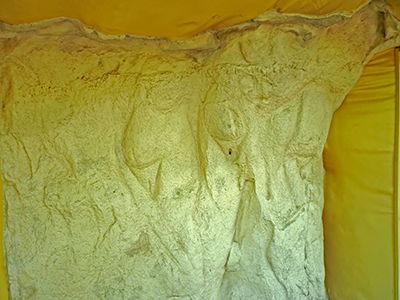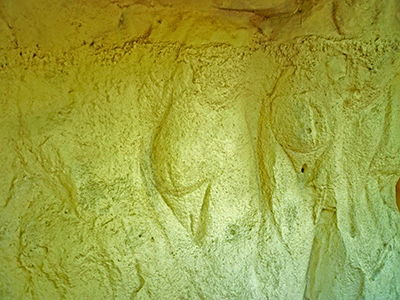Back to Don's Maps
 Back to Archaeological Sites
Back to Archaeological Sites
Roc aux Sorciers

Roc-aux-Sorciers, l'abri Bourdois
Photo: © 2008 Joël Jalladeau, http://jalladeauj.fr/sorciers/index.html
Roc-aux-Sorciers is an Upper Paleolithic rock shelter site dating to the mid-Magdalenian cultural stage, ca 14 000 BP, made famous by its relief wall carvings. The site is in the French commune of Angles-sur-l'Anglin, in Vienne. The name 'Sorcerers' Rock', with its suggestions of pagan rendez-vous, was applied to the site long before the wall-carvings were discovered. The south-facing rock-shelter at the base of the slopes of the Douce, above the right bank of the Anglin, about 1.5 km above the village, is composed of two geologically distinct sections; below is the Abri Bourdois, a classic rock-shelter site beneath a slight overhang, and above is the Cave Taillebourg, a deeper vestibule. The two parts are separated by a zone that has not yet been excavated, kept in reserve. The site was classed a Monument Historique on 18th January 1955. The art of Roc-aux-Sorciers is in two distinct categories - a 20 metre long frieze, 2.6 metres high, still standing, not open to the public, and a series of sculptures, formerly on a wall of a collapsed section of the site, fifty of which are now preserved and on display at the Musée d'Archéologie Nationale (MAN) at Saint-Germain-en-Laye. The site lies about 1.5 km downstream from the village of Angles-sur-Anglin, on the right bank of the Anglin. It faces to the south.
Text above adapted from Wikipedia.
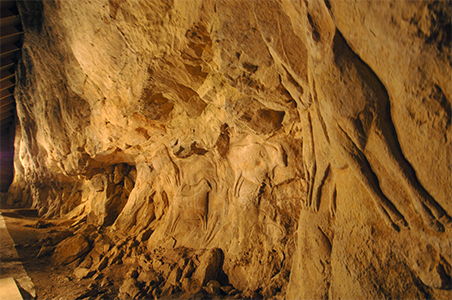
General view of the l'abri Bourdois frieze.
Photo: G. Pinçon, cl. Philippe Plailly
Text and source: http://www.sculpture.prehistoire.culture.fr/en/roc-aux-sorciers.html
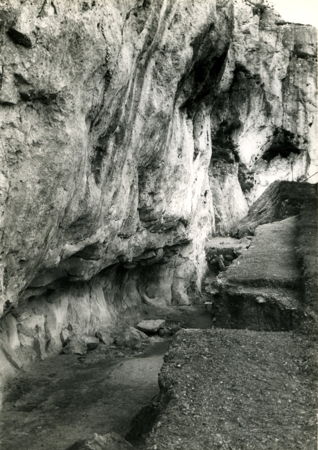
Overview of l'abri Bourdois, while being excavated in the 1950s.
Photo: MAN, Fonds Saint-Mathurin
Text and source: http://www.sculpture.prehistoire.culture.fr/en/roc-aux-sorciers.html
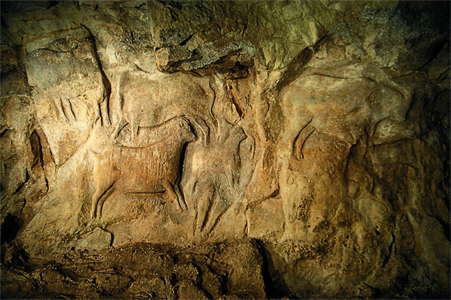
Another view of the frieze at Roc-aux-Sorciers, 15 000 BP.
Geneviève Pinçon, the chief archaeologist at the site, points out that the south-facing cavern was exposed to the sun for large parts of the day in pre-historic times. France had a Siberian climate 15 000 years ago. The cavern would have had a pleasant micro-climate, ideal to live in.
Photo: G. Pinçon, ministère de la Culture
Permission: (Reusing this file) G. Pinçon, ministère de la Culture, Public Domain.
Text: http://archaeologybriefs.blogspot.com.au/2008_03_01_archive.html
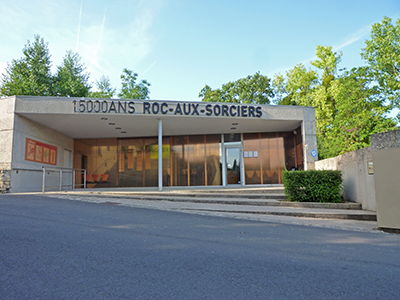
The Roc-aux-Sorciers Museum, the Centre d'interprétation de la frise magdalénienne du Roc-aux-Sorciers.
Photo: Ralph Frenken 2015
History
Lucien Rousseau discovered the site in 1927 and published his findings concerning the Magdalenian occupation he identified in 1933. In 1948, Suzanne Cassou de Saint-Mathurin reopened the site, excavating it intensively until 1957. Working with Dorothy Garrod, she discovered the sculpted frieze in 1950 and published several articles about it.Text above: http://www.sculpture.prehistoire.culture.fr/en/roc-aux-sorciers.html
The site was made a listed monument on 18 January 1955. At her death in 1991, de Saint-Mathurin donated the site and her collections to the French State. At her request, Geneviève Pinçon carried on the excavations, and in 1997 published - with Ludmila Iakovleva - the part of the sculpted frieze still in situ, carrying out the work with a multidisciplinary team of young researchers.
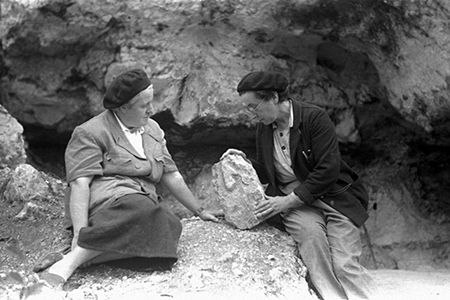
Suzanne de Saint-Mathurin with Dorothy Garrod. The two archaeologists reopened the excavations begun by Lucien Rousseau. In this image, taken in September 1948, they are moving a sculpted stone block depicting a bison hoof that had fallen from the ceiling of the Taillebourg Cave. The block is currently in the collections of the National Archaeological Museum at Saint Germain en Laye.
Photo: MAN, Fonds Saint-Mathurin
Source and text: http://www.sculpture.prehistoire.culture.fr/en/roc-aux-sorciers.html
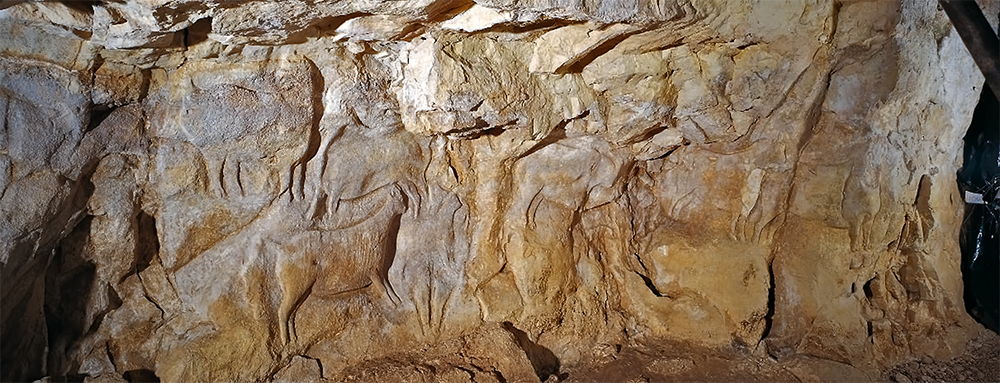
Another view of the frieze at Roc-aux-Sorciers, showing more of the surrounding area.
The site is enclosed by a structure built in 1993 to protect it.
Photo: © Pinçon
Source: http://www.sculpture.prehistoire.culture.fr/en/contenu/wall-sculpture.html
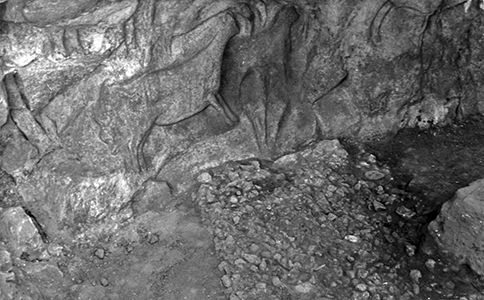
View of the site being excavated by Suzanne de Saint-Mathurin in the 1950s. The connection between the Magdalenian occupation layers (paving with small stones) and the wall sculptures is clearly visible.
Photo: MAN, Fonds Saint-Mathurin
Source and text: http://www.sculpture.prehistoire.culture.fr/en/roc-aux-sorciers.html
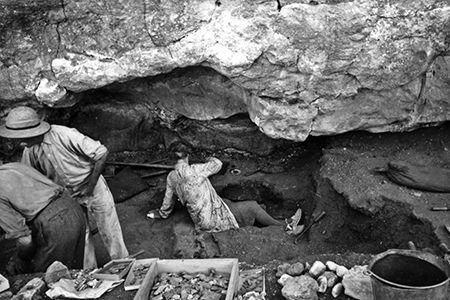
Photograph of the 1950s excavation campaign.
Suzanne de Saint-Mathurin and Dorothy Garrod's curiosity about a small, ground-level niche led them to excavate it. They discovered the 'Panel of the aware horse' (horse turning its head, Panel 2? - Don ) in l'abri Bourdois in 1950.
Photo: MAN, Fonds Saint Mathurin
Text and source: http://www.sculpture.prehistoire.culture.fr/en/roc-aux-sorciers.html

Saint-Mathurin and Abbé Breuil discuss the carved blocks from the ceiling of the Cave Taillebourg at Roc-aux-Sorciers, July-August 1949.
Photo: www.sculpture.prehistoire.culture.fr
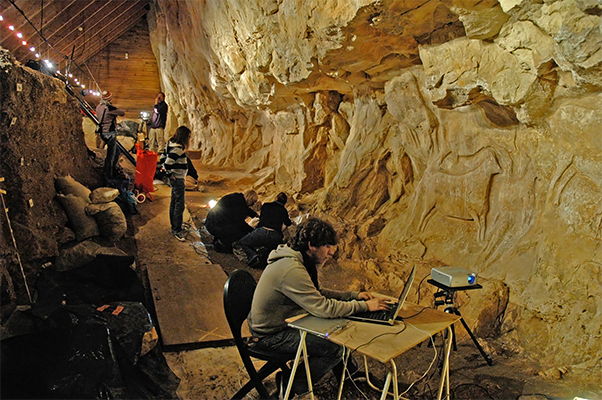
The research team on the site at Roc-aux-Sorciers.
This is a good photo of the work area in front of the frieze, now protected from the elements.
Photo: B. Spotorno, © G. Pinçon Drac Poitou-Charentes, http://www.sculpture.prehistoire.culture.fr/en/contenu/research.html
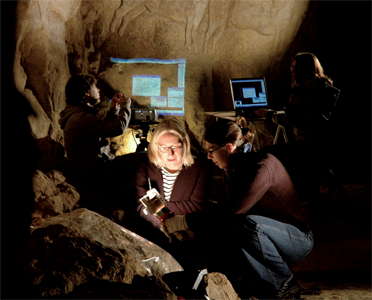
The research team on the site at Roc-aux-Sorciers.
G. Pinçon, leader of research at the site, at centre left.
Photo (left): B Spotorno, © G. Pinçon, ministère de la culture, Cliché B Spotorno, Fuentes (no date)
Photo (right): B. Spotorno, © G. Pinçon Drac Poitou-Charentes, http://www.roc-aux-sorciers.com/recherches-en-cours/
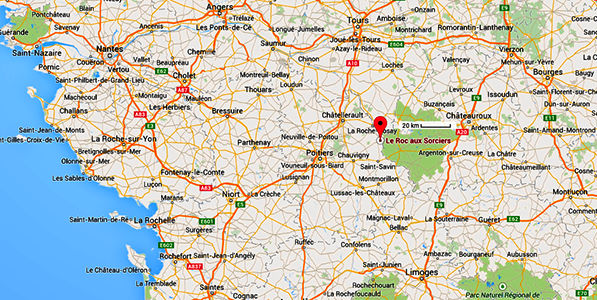
Location map.
Photo: Google maps
The history of discoveries at Roc-aux-Sorciers begins in 1927, when Lucien Rousseau discovered the Paleolithic habitation and identified it as mid-Magdalenian in its culture. He began excavations in the Cave Taillebourg and recovered an engraved stone in which Henri Breuil detected the representation of a mammoth.
Some years later, Suzanne de Saint-Mathurin became aware of Rousseau's article and decided to explore further, hoping to find some incised plaquettes like those from the cave at Lussac-les-Châteaux, also in Vienne. Assisted by her friend Dorothy Garrod, she carried out a decade of intensive campaigns between 1947 and 1957, and followed more sporadically until 1964.
The team discovered carved blocks with sculpted and incised figures, sometimes painted, of bison, horses, wild goats, felines and the figure of a man. It soon became clear that these fragments had fallen from the roof of the Cave Taillebourg. Only the carved and painted figure of a bison had remained in place.
Text above adapted from Wikipedia.
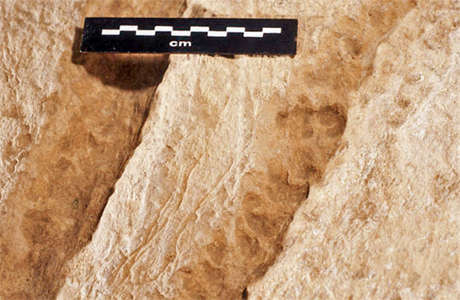
Panneau - fine engravings on the cliff face.
Photo: © G. Pinçon et DRAC Poitou-Charentes, 1997, Pinçon (2008)
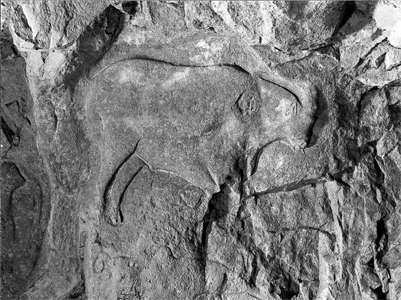
Male Ibex carved over older figures of bison and horse.
Photo: © Musée d’archéologie nationale, fonds Saint-Mathurin, Pinçon (2008)
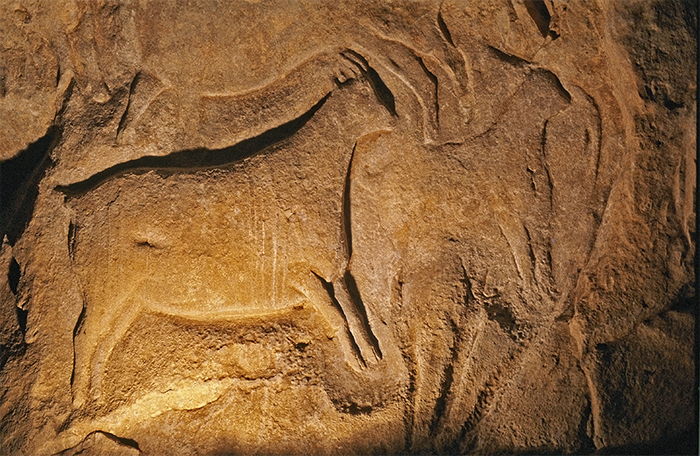
Female ibex and young ibex sculpted on the frieze of l’abri Bourdois du Roc-aux-Sorciers
Photo: © G. Pinçon et DRAC Poitou-Charentes, 2005
Source: www.sculpture.prehistoire.culture.fr

Part of the sculpted frieze of the Abri Bourdois, the lower of the two sites at Roc aux Sorciers.
This is a facsimile, one of the facsimiles on the wall outside the Roc-aux-Sorciers museum building.
This sculpted frieze is exceptional for the evidence it offers of the technical mastery of Magdalenian sculptors, for the anatomical details and the impression of power given to volumes in the play of firelight. Both animal and human figures strive for realism, a rarity in paleolithic art that reinforces the unique value of the site.
The excavations brought to light the evidence of human occupation associated with this wall art, of a material culture represented in jewelry, lamps, and tools in flint, in bone and horn and in ivory. The frieze, some twenty metres in length, is an impressively monumental work of art. Numerous finely engraved figures show that graphic values could be expressed on an intimate scale as well.
Photo: greg8486 via Panoramio
Text: Adapted from Wikipedia

A photograph of the frieze taken through the wire mesh that protected the site in the mid 1960s.
One of the three panels ornamented with carved representations of ibex: a female and her young depicted life size.
Above this female we can see the legs of a male ibex.
Photo: © 2008 Joël Jalladeau
Source: http://jalladeauj.fr/sorciers/index.html
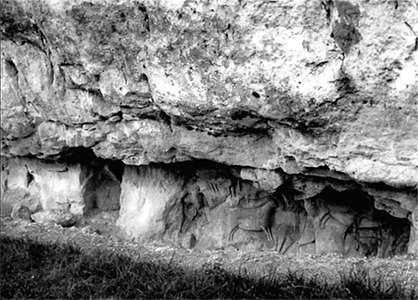
Part of the sculpted frieze of the Abri Bourdois, the lower (further downstream) of the two sites so far excavated at Roc aux Sorciers.
This is a photo of the original frieze in situ.
Photo: http://www.mutita.co.uk/
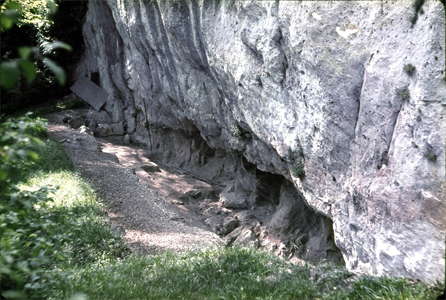
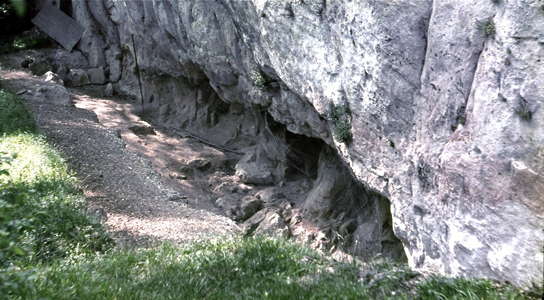
These are very valuable photos to have, a general view of the area around l'abri Bourdois.
In the 1960s the only covering was a bit of wire netting over the sculptures.
Photo: © 2008 Joël Jalladeau
Source: http://jalladeauj.fr/sorciers/index.html
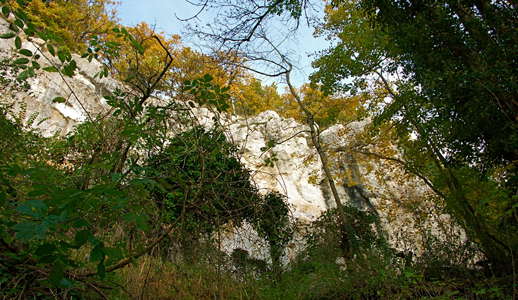
The cliffs behind the archaeological site, apparently taken in early autumn.
Photo: © 2008 Joël Jalladeau
Source: http://jalladeauj.fr/sorciers/index.html
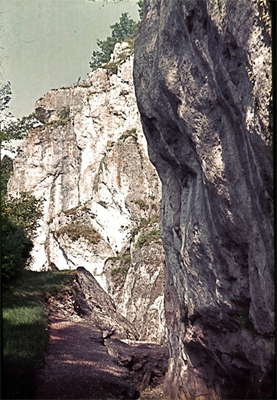
This is a photo of the area in the mid 1960s.
Photo: © 2008 Joël Jalladeau
Source: http://jalladeauj.fr/sorciers/index.html
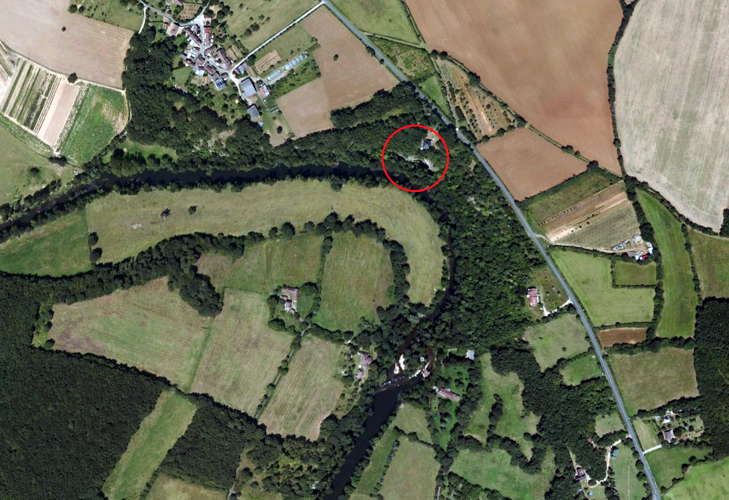
Aerial view of the cliffs of Dousse containing the caves, circled.
Photo: Google Earth

Roc aux Sorciers aerial view. The shelter sits at the foot of high limestone cliffs and faces south.
The Magdalenian era vegetation would have been sparser.
Photo: Philippe Plailly
Source and text: http://www.sculpture.prehistoire.culture.fr/en/roc-aux-sorciers.html
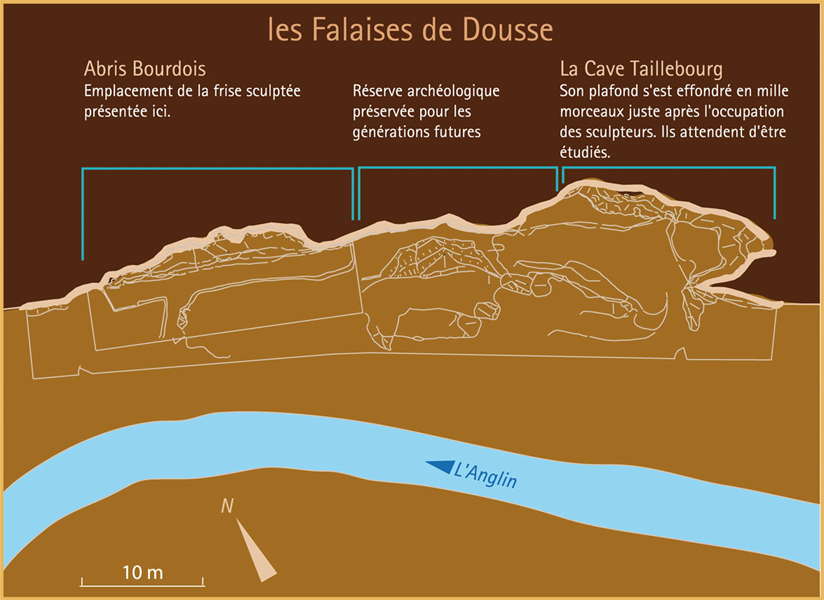
Topographical plan of the site.
The legend reads:
The cliffs of Dousse
Abri Bourdois
Location of the sculpted frieze.
Preserved archaeological reserve for future generations
La Cave Taillebourg
Its ceiling collapsed into pieces just after the occupation of the sculptors. They are waiting to be explored.
Photo: © Geneviève Pinçon,Gulliver d’après le relevé topographique de F. Rouzaud, Y. Le Guillou.
Source: Pinçon (1993)
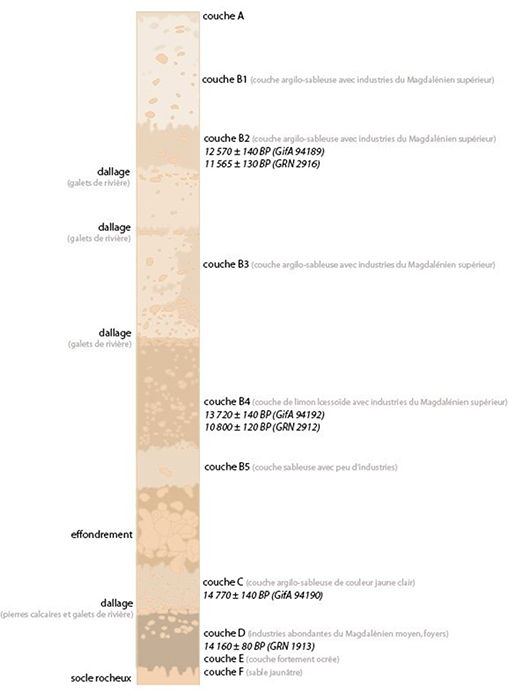
Stratigraphic view of Roc aux Sorciers.
This coupe of l'abri Bourdois shows the stratigraphy of the deposits from prehistoric times to the present.
Photo: G. Pinçon, after S. de Saint-Mathurin 1984, habillage Aurélie Abgrall
Source and text: http://www.sculpture.prehistoire.culture.fr/en/roc-aux-sorciers.html
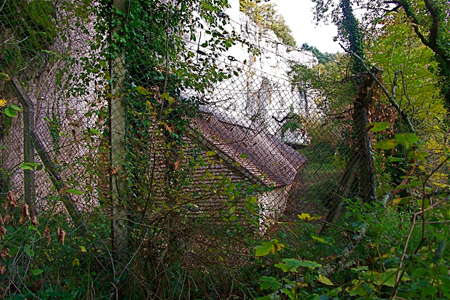
The area with the frieze, l'abri Bourdois, was protected by this structure built in 1993.
Photo: © 2008 Joël Jalladeau
Source: http://jalladeauj.fr/sorciers/index.html

This photograph from the 1950s shows the excavation of l'abri Bourdois at Roc aux Sorciers. This work revealed the wall sculptures in their archaeological context.
Photo: MAN, Fonds Saint-Mathurin
Source and text: http://www.sculpture.prehistoire.culture.fr/en/roc-aux-sorciers.html
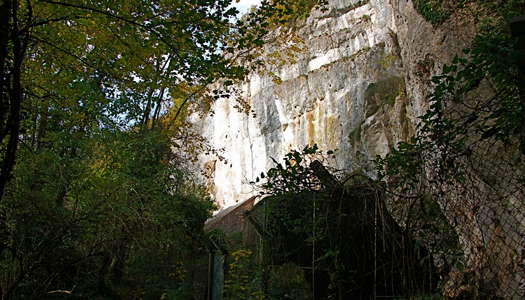
This area is the Cave Taillebourg, which collapsed in ancient times.
Photo: © 2008 Joël Jalladeau
Source: http://jalladeauj.fr/sorciers/index.html
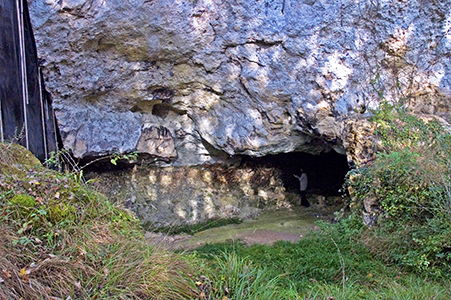
Current view of the Taillebourg Cave following excavations.
Photo: © Geneviève Pinçon
Source and text: http://www.sculpture.prehistoire.culture.fr/en/roc-aux-sorciers.html

This photograph from the 1950s shows Suzanne de Saint-Mathurin sorting the sculpted, engraved, and painted stone blocks, nearly one thousand of them, that fell from the ceiling of the Taillebourg Cave after it was occupied by the prehistoric sculptors.
Photo: MAN, Fonds Saint-Mathurin
Source and text: http://www.sculpture.prehistoire.culture.fr/en/roc-aux-sorciers.html
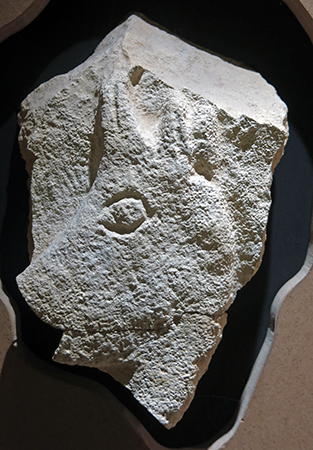
Head of a chamois, a sculpture from the collapsed limestone wall.
Photo: Don Hitchcock 2014
Source: Musée d'Archéologie Nationale et Domaine, St-Germain-en-Laye


Head of a chamois, one of the sculptures from the collapsed limestone wall.
Photo: Don Hitchcock 2014
Source: Musée d'Archéologie Nationale et Domaine, St-Germain-en-Laye
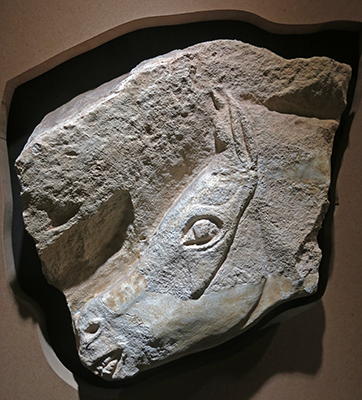
Engraving of a horse on stone, Angles-sur-Anglin, Vienne, France, Magdalenian.
This is a masterwork. The artist knew and understood horses intimately.
Photo: Don Hitchcock 2014
Source: Musée d'Archéologie Nationale et Domaine, St-Germain-en-Laye

Bas relief of a bison in right profile on Jurassic oolitic limestone.
Length 350 mm, width 310 mm, thickness 160 mm.
This block is a limestone fragment of the ceiling of the Taillebourg Cave. It bears evidence of black and red colourants.
Photo: Don Hitchcock 2014
Source: Musée d'Archéologie Nationale et Domaine, St-Germain-en-Laye
Text: Adapted from http://www.catalogue-roc-aux-sorciers.fr/
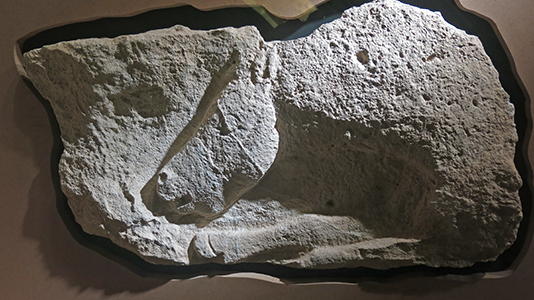
Head, neck and front legs of a horse.
Photo: Don Hitchcock 2014
Source: Musée d'Archéologie Nationale et Domaine, St-Germain-en-Laye
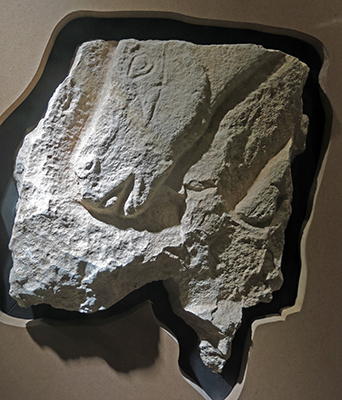
Head of a horse.
Photo: Don Hitchcock 2014
Source: Musée d'Archéologie Nationale et Domaine, St-Germain-en-Laye
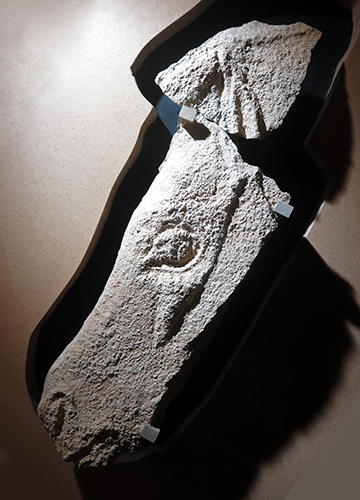
Head of a horse.
Photo: Don Hitchcock 2014
Source: Musée d'Archéologie Nationale et Domaine, St-Germain-en-Laye

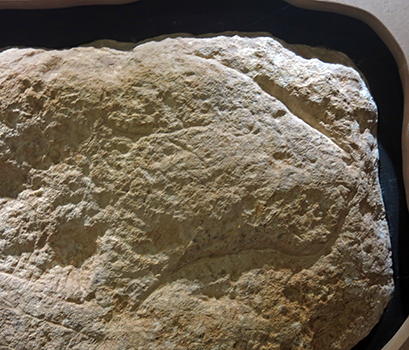
Head of a feline.
Photo: Don Hitchcock 2014
Source: Musée d'Archéologie Nationale et Domaine, St-Germain-en-Laye
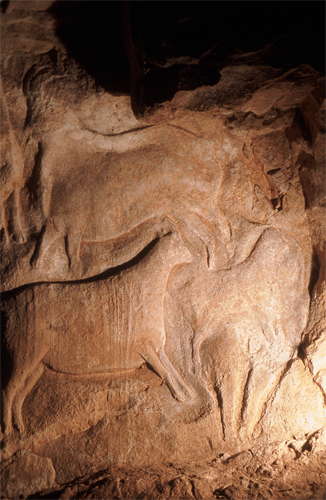
Panneaux bouquetins.
Photo: roc.sorciers, © G. Pinçon - DRAC Poitou - Charentes. Cliché G. Pinçon
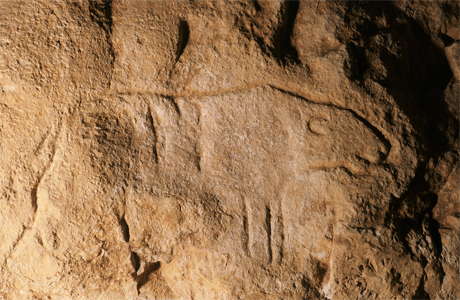
Feline, possibly a cave lion.
Photo: roc.sorciers, © G. Pinçon - DRAC Poitou - Charentes. Cliché G. Pinçon
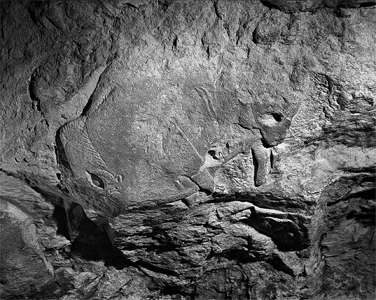
Bison sculpted on the ceiling of the Cave Taillebourg, de Saint-Mathurin, S.
This is the only sculpture still in situ where it was carved in the Cave Taillebourg. The rest have fallen from the original frieze.
Photo: © Musée d’archéologie nationale, fonds Saint-Mathurin.
Photo: Pinçon (1993)

Bison sculpted on the ceiling of the Cave Taillebourg, as above.
This appears to be a digital stitch of a series of photographs.
Photo: www.sculpture.prehistoire.culture.fr
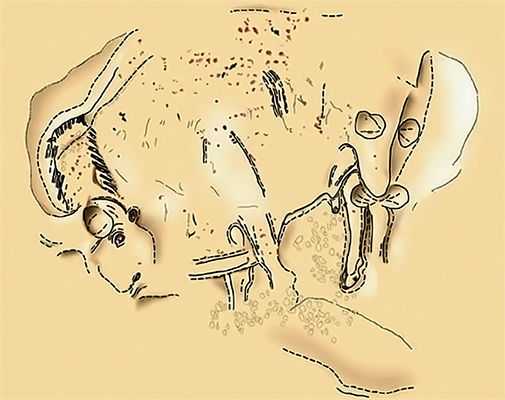
Drawing of the bison above, BDD 121.
Photo: © Geneviève Pinçon, ministère de la Culture, ill.
Source: http://www.catalogue-roc-aux-sorciers.fr/html/12/selection/page_notice-ok.php?Ident=D&NoticeId=118&StatDomain=Les%20anneaux%20complets&myPos=1
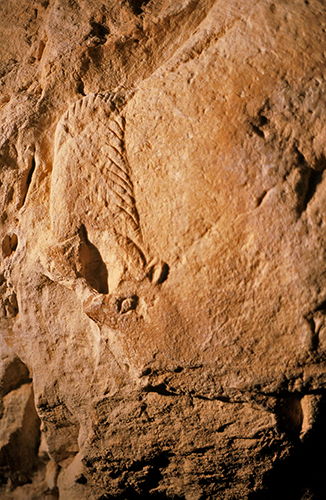
This image gives a much better view of the bison head.
Photo: © Geneviève Pinçon, Ministry of Culture, ill. Geneviève Pinçon, 1997
Source: http://www.catalogue-roc-aux-sorciers.fr/
The bison sculpture shown above is on the ceiling of the Taillebourg Cave. This piece is in bad condition, with fractures, old and new scaling, calcification and erosion. Field notebook reference: 1949-06-30.
This is a bas relief with steep edges, and exhibits pecking, scraping, carving, red and black colouring. The animal is seen walking in left profile. It is carved in bas relief with an abrupt edge and with large clearances for margins around the head (11cm) and the rump (14 cm).
The sculpture is of the order of 3 cm thick on average. It is of a bison, one third natural size. It is possible to note modelling at the shoulder using grazing, very horizontal lighting.
The head is complete and very detailed. The muzzle is damaged. The eye is almond shaped. The pupil and the brow are in relief. The ear is oval with a raised bead/bulge. Small fine incisions are visible on the ear. The left horn is double curved, embossed, directed forward, and its end is fractured. The inner edge of the horn follows the contour of an anneau ( double ended hole passing in and out of the ceiling, used as an attachment point for a cord or rope - Don ) carved in the forehead of the animal. The right horn is sketched in the background of the forehead. The topknot is particularly well modelled.
Its elongated shape is backed by a line evoking the volume of the bristles at this point. Geometric decoration is used as a filler in the interior of the outline of this representation. The outline is marked by a dotted line and a continuous scraping. Filling of this volume is achieved by means of deep and wide oblique grooves. Pecking continues at the hump and has been used for the modeling. This geometric stylisation is common in Angles and belongs to the 'style' of Angles. The muzzle is largely fractured. A relief fragment belonging to the left nostril is still clearly visible.
The hollow of the nostril is marked by an indentation. A fragment of the upper lip is still recognisable. The beard is fractured. It seems that another sculpture was begun previously on this anatomical part. The dewlap is indicated and emphasised by a horizontal band edged in relief. The trait of geometrical filling may be observed in other ibex and bison of the Roc de Sorciers.
The legs are depicted with some detail. The left foreleg presents a modelled shoulder in relief. It is offset towards the rear with respect to the right leg, which is further forward. On each, a line has been cut, indicating the muscle. The right foreleg was destroyed at the hoof by persistent pecking, indicating that it was done deliberately by human action. It is the same for the left foreleg, although there part of the hoof and ergot remains.
This anthropogenic intervention marks a recutting of the sculpture at that point. Indeed, close by, a dorsal line marks the placement of a sculpture for which the field was cleared, which resulted in the partial destruction of the front legs of the bison.
The line of the abdomen is set in relief. A recent flake has affected the size of the stomach. The attachment of the penis is geometric, (in the form of a 'drop'). It is emphasised by wide engraved lines associated with its relief. The end of the penis is clear and rounded. It has been painted with black pigment.
The right hind leg is complete, with the detail of a cloven hoof also having been coloured black.
A line is here also incised on the hock. The right hind leg has suffered more, the hoof is fractured. In addition, an anneau was carved at this leg, reducing its size. It is fractured.
The line of the buttock is very straight. A large anneau was formed on the thigh using the high relief of this part of the animal. This ring is undamaged. The posterior part of the animal shows a peculiar image on the hindquarters. It appears that a triangular head was sculpted there. You can follow piecemeal the dorsal line of the bison.
At the edge of the region at the hump of the back, red dots are visible. Colour is used in several places on this animal: black is used on the hoof, the penis, and the hump on the back of the bison. Some engraved elements are also superimposed on the animal. In particular, two parallel, elongated, irregular shapes are engraved on the side of the bison.
Fractures, mostly ancient ones, affect the back and hindquarters of the bison and the space around the forequarters. The subject has been carved on the edge of a granular limestone layer rich in fossils and a limestone layer of finer and more uniform grain. Both limestone beds are horizontal and overlap. The more lumpy layer, the less well preserved, is in the upper level. The more compact layer corresponds to the lower layer at the Bison torso and legs. Scaling and recent erosion in places show the underlying white rock (for example at the topknot).
Thick calcite covers the beard and forequarters. This wildlife subject carries two large complete anneaux or rings, and a fractured anneau. The one at the front is complete, on an east-west axis; the bridge is eroded; it is of 17 cm maximum width. The second on the rump is full and large. It is also oriented east-west. It measures 11 cm in maximum width. The last link is broken, and it is also oriented east-west ( at the back legs - Don ). It measures 10 cm in its greatest width.
The rings or anneaux in place on the ceiling of the cellar Taillebourg are oriented east-west. Their distribution is interesting to study. They are associated with the bison and are large because they are not carved on natural edges, as in the Bourdois shelter, but actually on the ceiling, on which the only usable edges were those formed by the animal reliefs. This context leads, it seems, to the manufacture of larger rings.
Text: translated by Don Hitchcock from http://www.catalogue-roc-aux-sorciers.fr
Reference:
Pinçon (2007b)

Geneviève Pinçon
Chef du bureau de l'élaboration et de l'utilisation des inventaires archéologiques
Sous-direction de l'archéologie
Ministère de la culture et de la communication
Dr Pinçon has had a very distinguished career in Archaeology, and has been responsible, amongst other things, for the wonderfully high standard of research at Roc-aux-Sorciers.
Dr Pinçon has made available to the public the important finds at Roc-aux-Sorciers, and continues to direct research at the site. She is a tutor of doctoral students and a member of various scientific committees including the promotion of research at Chauvet Cave.
Dr Pinçon has published, and continues to publish, many important scientific papers.
Photo: http://www.mae.u-paris10.fr/arscan/IMG/article_PDF/article_a994.pdf

Ongoing Preliminary Multimedia Project
This is a wonderful project to obtain a database of the main panel from Roc-aux-Sorciers, and it has been beautifully done.
Photo: Cultural Laboratory A + H / OlivierAuber , JulienMarcland , OscarFuentes
Source:http://sorciers.km2.net/wakka.php?wiki=PointsDeRepere
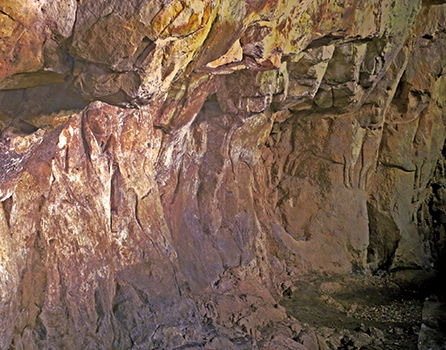
General view of the right hand side of the frieze.
Photo: Unknown, but probably © Geneviève Pinçon
Rephotography : Don Hitchcock 2014
Source: Display, Centre d'interprétation de la frise magdalénienne du Roc-aux-Sorciers
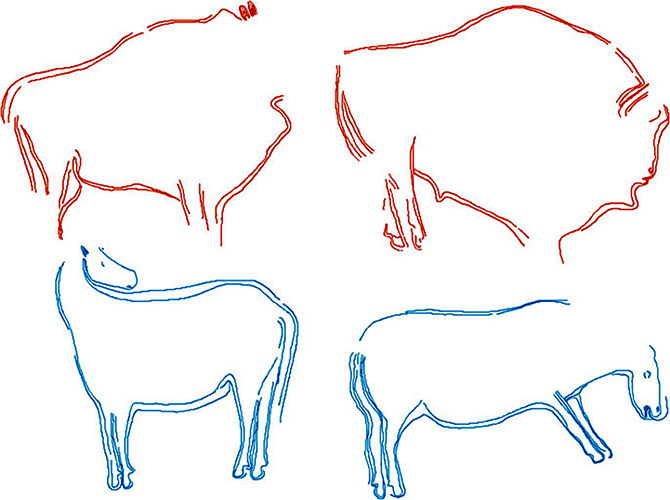
Zone Figurative 1, Panneau 1, Zone Figurative 2, Panneau 2, Zone Figurative 2, Panneau 3.
Line drawing of the sculptures on the panels
Photo: Drawing G. Pinçon, L. Iakovleva et O. Fuentes © G. Pinçon.
Source: http://www4.culture.fr/patrimoines/patrimoine_monumental_et_archeologique/sdx/api-url/getatt?app=fr.gouv.culture.inventaire.revue&id=pincon-1387_img9
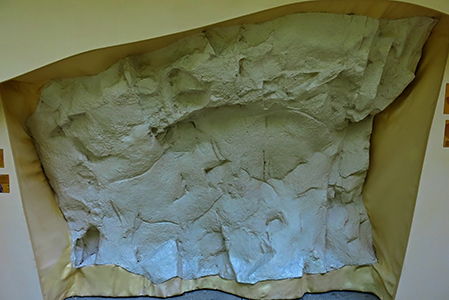
Zone Figurative 1, Panneau 1
This panel features two bison.
Photo: Don Hitchcock 2014
Source: Display, Centre d'interprétation de la frise magdalénienne du Roc-aux-Sorciers

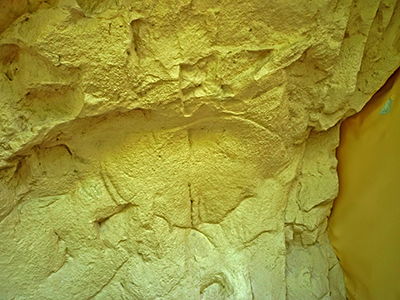
Zone Figurative 1, Panneau 1
Closeups of the two bison.
Photo: Ralph Frenken 2015
Source: Display, Centre d'interprétation de la frise magdalénienne du Roc-aux-Sorciers
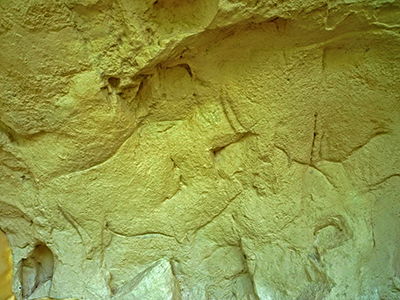
Zone Figurative 1, Panneau 1
Closeup of the bison on the left of the panel.
Photo: Ralph Frenken 2015
Source: Display, Centre d'interprétation de la frise magdalénienne du Roc-aux-Sorciers
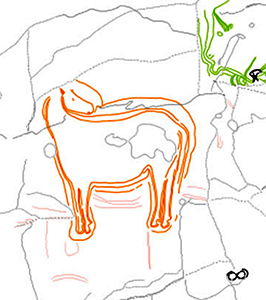

Zone Figurative 2, Panneau 2.
Horse from abri Bourdois. This is the horse looking over its shoulder or 'the horse of discovery', Panel 2, Ch1, BDD 235.
Support: Oolitic Jurassic limestone, with the wall prepared by hammering/pecking. The sculpture is on a prepared, flat, vertical wall bounded by edges. It is in a bad condition, with calcification, fractures, cracks, scaling, cupules, and scratch marks dating from the excavation.
Length of torso 696 mm, height at the withers 600 mm, height of the body 608 mm, width of the body 331 mm, length of the head 2017 mm, width of the head 85 mm.
Comments of Suzanne de Saint-Mathurin:
'In the afternoon, cleaning stones is continued along the line where the overhang of the roof is visible. It is blocked at the vault, except at the downstream end where the rock rises a little. Here we cleaned out a kind of alcove, in which a small horse's head is visible on the back wall. The body is buried under rubble, but it appears to be looking back over its shoulder.' (Wednesday, 14th June, 1950, excavation notes)
'In the afternoon, we deepened the trench, and it is decided to uncover the horse in the alcove. At first a white residue deposited along the back was removed, then dirty earth. Gradually the legs become visible, then the feet. The tail is long, descending to ground level. The two forelegs and two hind legs are placed together. The sculpture has a fine attitude with sharp detail. Some stiffness. It is washed.' (Friday, 16th June 1950, excavation notes). Field notebook reference: 1950-06-14.
The sculpture has been done in low relief, and has been created by carving and polishing.
The horse called 'Discovery' (Ch1), is seen in left profile. It is standing with legs straight and together, and its head is turned backwards. In the words of Abbé Breuil, it is in the 'agnus dei' position ( referring to the horse from la Grotte de Pair-non-Pair - Don ).
Despite its poor state of preservation, this horse still has many anatomical details: nostril, mouth, modelling on the cheek, ear tip, hoof, ergot ( a small callosity on the underside of the fetlock of a horse - Don ), the bend of the hock. The eye is suggested by a cupule. Only the line of the neck, receding into the wall, is not represented.
The horse's head and the rest of his body were not represented on the same level, reflecting a sense of depth: the head is actually embedded in the wall. A second line is engraved along the belly as well as a line along the tail that might not belong to the horse described. Is this to suggest, by these partial elements, a second horse in the background?
Reference: Iakovleva et Pinçon (1997)
Photo (drawing) © Geneviève Pinçon, ministère de la Culture, ill. Geneviève Pinçon, Ludmila Iakovleva, Oscar Fuentes, 1997-2004.
Photo: © Geneviève Pinçon, ministère de la Culture, ill. Geneviève Pinçon, 1997.
Text: translated by Don Hitchcock from http://www.catalogue-roc-aux-sorciers.fr
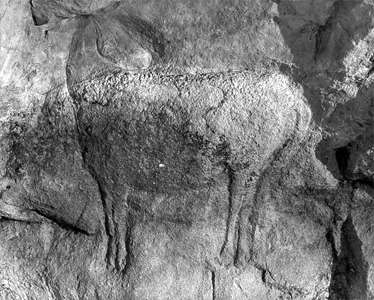
A black and white photo of the horse from abri Bourdois. This is the horse looking over its shoulder, Panel 2. The horse has a heavy thick body which contrasts with a thin elongated head.
Photo and text: Bourdier (2008)
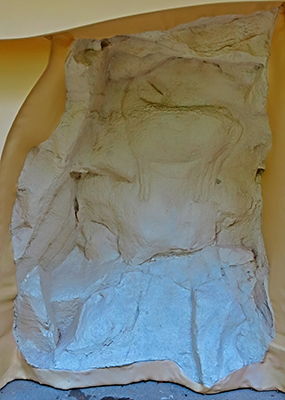
Zone Figurative 2, Panneau 2
This panel features the 'horse of discovery'.
Photo: Don Hitchcock 2014
Source: Display, Centre d'interprétation de la frise magdalénienne du Roc-aux-Sorciers
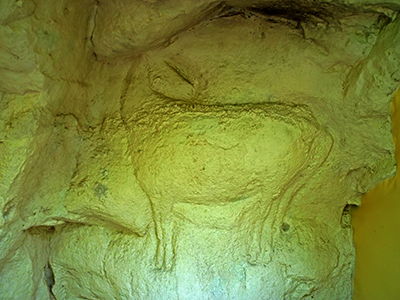
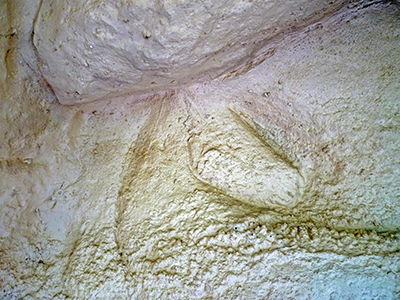
Zone Figurative 2, Panneau 2
Closeup of the horse.
Photo: Ralph Frenken 2015
Source: Display, Centre d'interprétation de la frise magdalénienne du Roc-aux-Sorciers
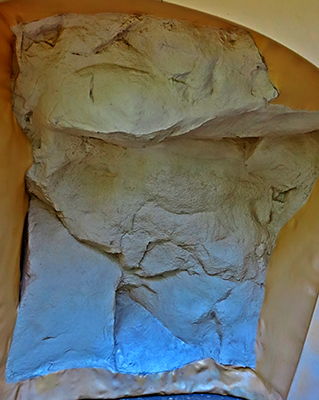
Zone Figurative 2, Panneau 3
This panel features a 'grazing' horse and an obscured bison, difficult to discern.
Photo: Don Hitchcock 2014
Source: Display, Centre d'interprétation de la frise magdalénienne du Roc-aux-Sorciers
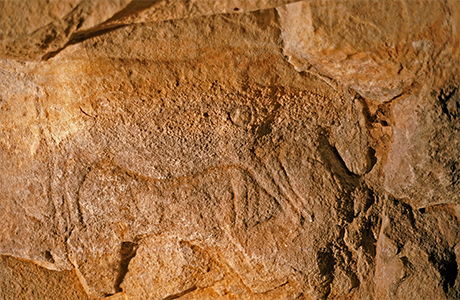
Zone Figurative 2, Panneau 3.
Horse 'grazing in right profile. Its relief is given by the natural form of the wall that the sculptor has used perfectly to advantage.
It is distinguished by its eye, with the nose shown clearly, and the mouth open. Two sets of forelimbs are carved, a shift of lighting giving the impression of a galloping horse.
Horses Panel. Abri Bourdois
Photo: © Geneviève Pinçon
Source and text: http://images.google.de/
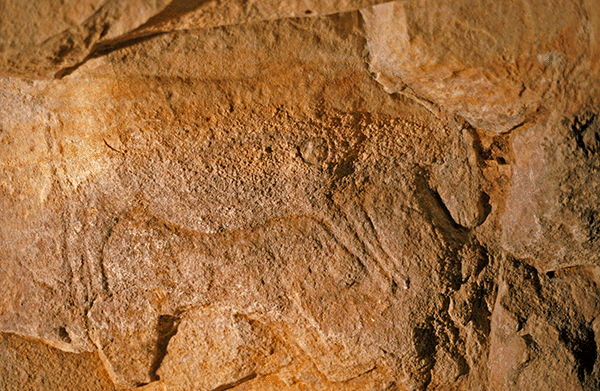
Zone Figurative 2, Panneau 3.
This shows the impression of a galloping horse.
Photo: © Geneviève Pinçon
Source: http://images.google.de/
Animation: Don Hitchcock, using the free app at http://gifmaker.me/
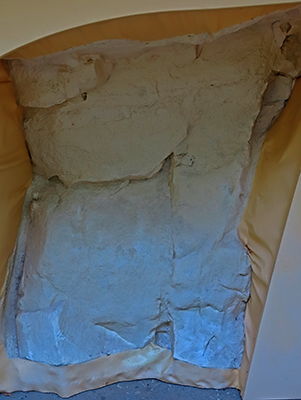
Panel to the immediate right of Zone Figurative 2, Panneau 3, known as Zone Non Figurative 2, which contains no significant carvings.
Photo: Don Hitchcock 2014
Source: Display, Centre d'interprétation de la frise magdalénienne du Roc-aux-Sorciers
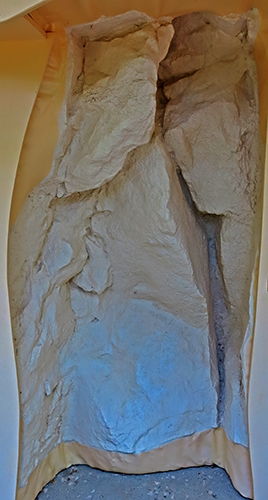
Panel to the immediate left of Zone Figurative 3, Panneau 5, known as Zone Non Figurative 2, Fa2, which contains no significant carvings.
Photo: Don Hitchcock 2014
Source: Display, Centre d'interprétation de la frise magdalénienne du Roc-aux-Sorciers

Zone Figurative 3, Panneau 5
Photo: Don Hitchcock 2014
Source: Display, Centre d'interprétation de la frise magdalénienne du Roc-aux-Sorciers

Zone Figurative 3, Panneau 5
Tê1, BDD 249
( This anthropomorphic face, identified as a human head, is at the top of the panel, above the female torsos. - Don )
Length 17 cm, width 12 cm.
Support: Oolitic Jurassic limestone, with the wall prepared by hammering/pecking. Vertical wall, convex in the horizontal plane, in average condition, with scaling, calcification, erosion, and concretions.
The human face has been carved on a natural relief of the wall; only the eyes and mouth were engraved. A significant hairstyle was probably modelled on this relief. The chin, pointed at the front, gives this carving a very refined look. The almond-shaped eyes are not detailed but are very expressive.
The human head is very eroded because it was not protected by a projecting layer of sediment above, as the venus figures below it were. This erosion prevents a detailed analysis of anthropogenic factors, which were certainly originally more present, as suggested by the remains of engraved lines at the mouth. Because of its shape, this human head can be compared to the human head carved on the fossil madrepore ( see below ).
This human head without a body is carved above all the women , but does not have a direct relationship with them. This location is not insignificant; the head appears to be missing the shared individuality of the female representations.
Thus, the three women carry a collective image, while the head reminds of the individual side of each of us. Nevertheless, the human face seems to hesitate between anonymity and particularly, simplification of anatomical details, rather than suggesting a trend toward anonymity.
Photo: © Geneviève Pinçon, ministère de la Culture, ill. Geneviève Pinçon, 1997.
Text: translated by Don Hitchcock from http://www.catalogue-roc-aux-sorciers.fr
Reference: Iakovleva et Pinçon (1997)
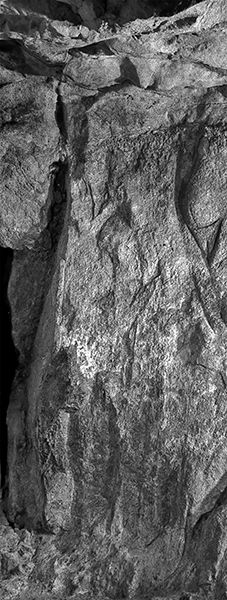
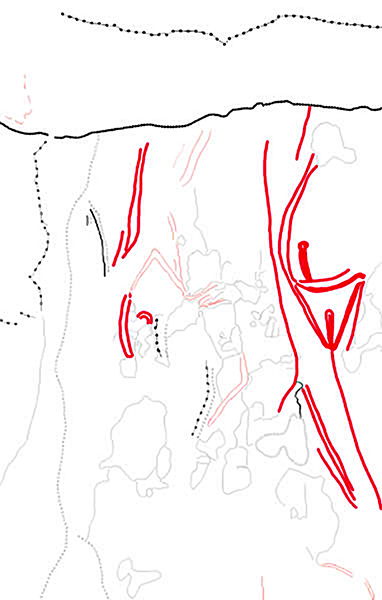
Zone Figurative 3, Panneau 5
Venus Vé1, BDD 330, a possible venus to the left of Venus Vé2.
Support: Oolitic Jurassic limestone, with the wall prepared by hammering/pecking. Vertical wall, convex in the horizontal plane, in good condition, with ancient cracks. Estimated maximum length 78 cm.
Longitudinal incisions mark the silhouette of a female subject close in proportion and position to that of of Venus Vé2. A small cupule on the same horizontal line as that of Venus Vé2 can be interpreted as the navel. However, this figure is very incomplete and has hammered/pecked zones (in the abdomen and legs).
Photo: © Geneviève Pinçon, ministère de la Culture, ill. Geneviève Pinçon, Ludmila Iakovleva, Oscar Fuentes, 1997-2004.
Text: translated by Don Hitchcock from http://www.catalogue-roc-aux-sorciers.fr
References:
Laming-Emperaire (1962),
Leroi-Gourhan (1965),
Iakovleva et Pinçon (1994),
Iakovleva et Pinçon (1997)

Zone Figurative 3, Panneau 5
Line drawing of the panel.
Photo: Drawing G. Pinçon, L. Iakovleva et O. Fuentes © G. Pinçon.
Source: http://www4.culture.fr
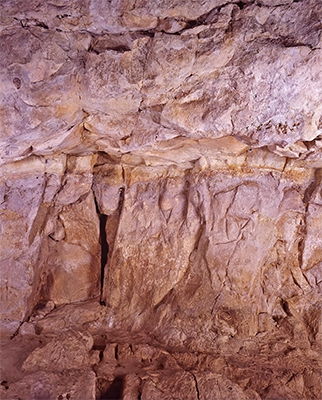
Zone Figurative 3, Panneau 5, BDD 238
View of the panel. The support is oolithic Jurassic limestone, with the surface prepared by pecking to provide a smooth surface. Height 200 cm, width at top 200 cm, at the bottom 250 cm.
The panel of venus figures includes a group of three women side by side, with no space between them, life-size and limited to the middle part of the body: head, arms and feet are not represented. These three women are distinguished within this unity, by their slightly different positions: the first three quarter view, the other two in a frontal view.
They also have different states of maturity. For the first, the roundness of the bulging belly is emphasised by a line connecting the navel to the pubic bone. This may indicate, in the opinion of several obstetricians, a young pregnant woman. The second figure has the rounder shape and emphasised breasts of a more mature woman. In the third, the curves are less pronounced, and it is not clear whether it is of a girl or an older woman.
The homogeneity of their proportions and their juxtaposition at the same height on a horizontal line invite the viewer to interpret them as an indivisible whole. At the same time, their different states, which reveal their individuality, make them complementary and reinforces their closeness. This overall interpretation of these works is supported by the inextricable combination of the third female representation with two depictions of bison, carved one above the other on a vertical axis perpendicular to that on which the venus figures have been carved.
Other representations are present on this panel: a human head (TE1) at the top of the panel, two bison (Bi4 and Bi5) superimposed on the third female representation, and a 'protome' or decoration of a deer (Ce1) engraved at the foot of bison Bi5. Several anneaux were carved in ridges ( anneaux are holes in the rock through which cords can be passed for the suspension of hides for curtains, and they are easier to make in ridges, where that formation exists, than in flat rock - Don ) and are closely associated with bison. Finally, fine engravings were found on a block on the ground.
The panel of Venus figures, at the centre of the frieze, is particularly prominent because of its strongly convex morphology. All the female representations are life-size, which remains unique in wall art. There are no other examples, to our knowledge, in the configuration of other archaeological sites.
However, the association of the human female with bison is a conventional one in Palaeolithic art. It was first described by Annette Laming-Emperaire (Laming-Emperaire, 1962), and then used by André Leroi-Gourhan.
The systematic representation of a triangle for the vulva, irrespective of the general position of the figure is consistent with representations of this anatomical detail, common in other sites in different periods.
Beyond their exception and specificity related to their association, their technical execution and their monumental aspect, these sculpted female figures offer similarities with other parietal female representations. These collective traits rather reflect a common cultural heritage spread over a large area, and this occurs throughout the Upper Palaeolithic period.
Photo: © G. Pinçon
Text: translated by Don Hitchcock from http://www.catalogue-roc-aux-sorciers.fr
References:
de Saint-Mathurin (1978),
Iakovleva et Pinçon (1995),
Iakovleva et Pinçon (1997),
Pinçon (2007a)

Zone Figurative 3, Panneau 5
These women, sometimes known in the literature as 'the three graces' (Caldwell, 2010), are represented in life size, and are unique in Palaeolithic art. The sculptor has translated with great realism different types of the female body, highlighting the importance of women in Magdalenian societies.
Above the female figures we can see an isolated sculpted head.
Photo: Don Hitchcock 2014
Source and text: Display, Centre d'interprétation de la frise magdalénienne du Roc-aux-Sorciers
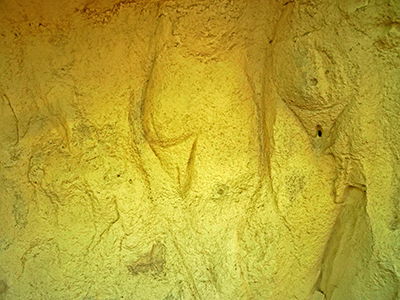

Zone Figurative 3, Panneau 5
Successive closeups of the panel.
Note that the female torso on the far right 'bends' around a natural curve in the rock, and is not obvious unless you know what to look for.
Photo: Ralph Frenken 2015
Source: Display, Centre d'interprétation de la frise magdalénienne du Roc-aux-Sorciers
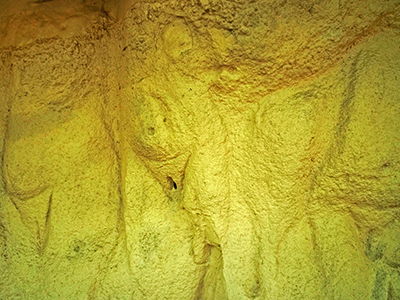
Zone Figurative 3, Panneau 5
Photo: Ralph Frenken 2015
Source: Display, Centre d'interprétation de la frise magdalénienne du Roc-aux-Sorciers
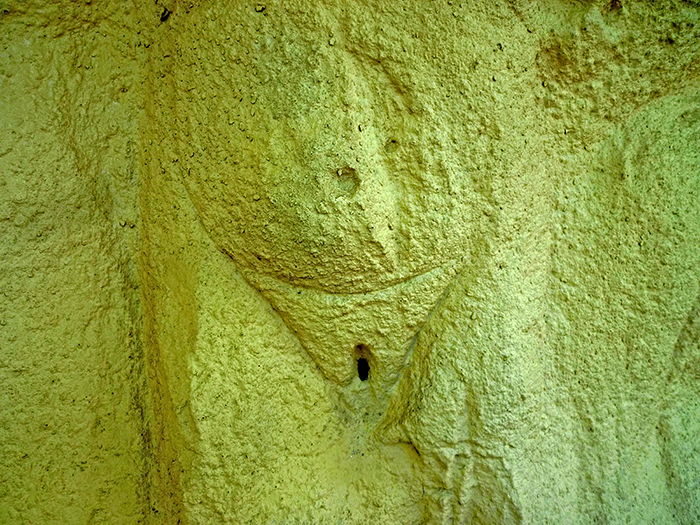
Zone Figurative 3, Panneau 5
This is an excellent high resolution closeup of the sculpture, clearly showing a pre-existing hole which has been incorporated into the engraving of the vulva in this sculpture.
Photo: Ralph Frenken 2015
Source: Display, Centre d'interprétation de la frise magdalénienne du Roc-aux-Sorciers
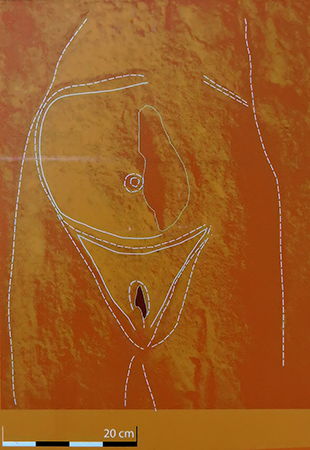
Zone Figurative 3, Panneau 5
Diagram of the sculpture above.
As noted earlier, the shape of the wall is used here to represent the vulva of the woman, which was carved around a natural hole.
Photo: Don Hitchcock 2014
Source and text: Display, Centre d'interprétation de la frise magdalénienne du Roc-aux-Sorciers
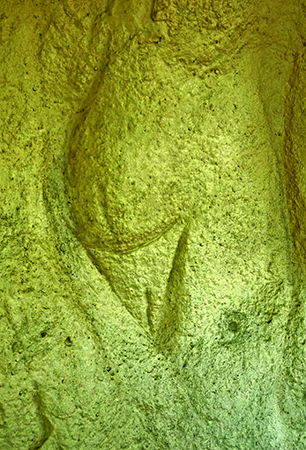
Zone Figurative 3, Panneau 5
Close up of the left hand female torso.
Photo: Ralph Frenken 2015
Source: Display, Centre d'interprétation de la frise magdalénienne du Roc-aux-Sorciers
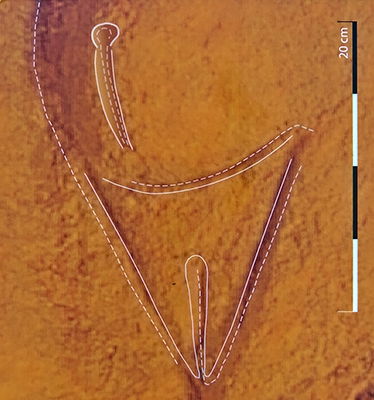
Zone Figurative 3, Panneau 5
Diagram of the sculpture above.
Photo: Don Hitchcock 2014
Source and text: Display, Centre d'interprétation de la frise magdalénienne du Roc-aux-Sorciers
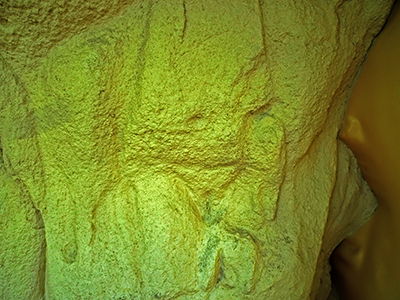
Zone Figurative 3, Panneau 5
Close up of the venus torso on the far right.
Photo: Ralph Frenken 2015
Source: Display, Centre d'interprétation de la frise magdalénienne du Roc-aux-Sorciers
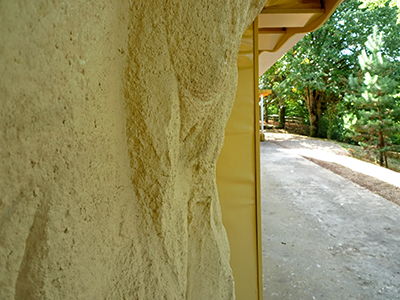
Zone Figurative 3, Panneau 5
This is a good photo showing the location of the facsimiles on the exterior wall of the museum.
Photo: Ralph Frenken 2015
Source: Display, Centre d'interprétation de la frise magdalénienne du Roc-aux-Sorciers
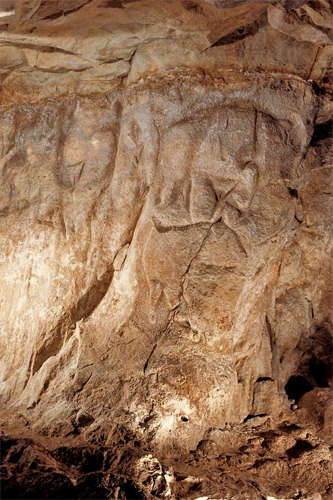
Female / bison still in place on the frieze of l’abri Bourdois du Roc-aux-Sorciers
Photo: © G. Pinçon et DRAC Poitou-Charentes, 1997, Pinçon (2008)

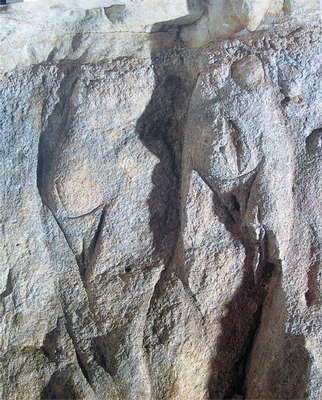
Female sculptures at Roc-aux-Sorciers.
On the left, a photo of two female figures taken through the wire mesh that protected the site in the mid 1960s. The sculptures were created, in part, at the expense of animal representations previously executed.
Photo and text (left): © 2008 Joël Jalladeau
Source (left) : http://jalladeauj.fr/sorciers/index.html
Photo (right): http://www.atramenta.net/lire/les-figures-humaines-dans-lart-paleolithique/23919
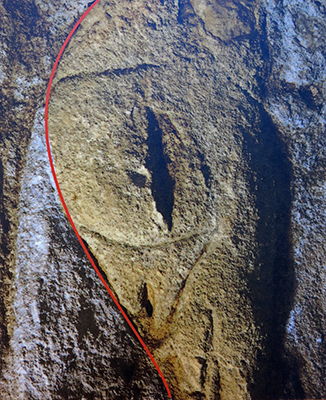
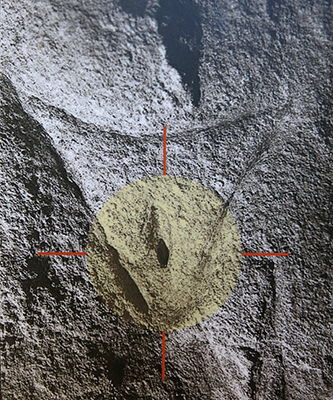
The sculptor used natural features of the existing wall to compose the carvings. Here, a pre-existing hole has been incorporated into the engraving of a vulva.
Photo: Don Hitchcock 2014
Source and text: Display, Centre d'interprétation de la frise magdalénienne du Roc-aux-Sorciers
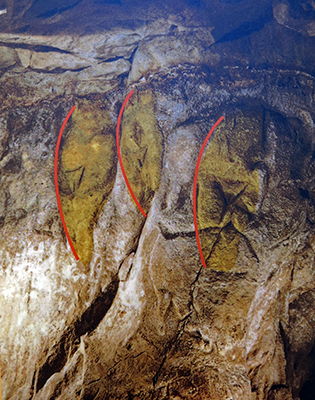
The shapes of the figures represented, and the original forms of the wall, are intimately linked in the design and completion of the sculpted figures.
Photo: Don Hitchcock 2014
Source and text: Display, Centre d'interprétation de la frise magdalénienne du Roc-aux-Sorciers
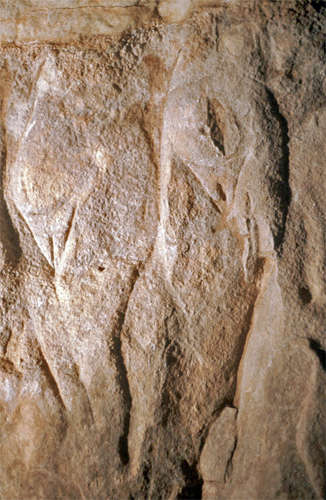
Venus figures carved into the stone of the cliff.
Photo: © G. Pinçon et DRAC Poitou-Charentes, 1994, Pinçon (2008)
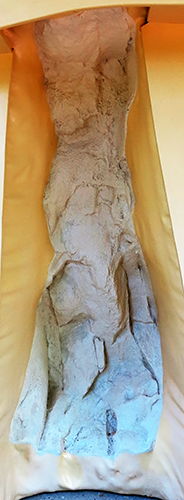
Zone Fa3
This is a connecting panel between Zone Figurative 4, Panneau 6 and Zone Figurative 3, Panneau 5.
Photo: Don Hitchcock 2014
Source: Display, Centre d'interprétation de la frise magdalénienne du Roc-aux-Sorciers
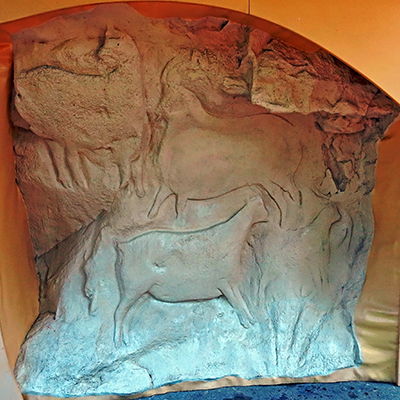
Zone Figurative 4, Panneau 6
The panel contains two horizontal registers. On the upper section, two ibex come together in ritual battle. On the lower, a young female ibex and a young ibex are shown.
Several of the sculptures are only vestiges of the originals, and are difficult to interpret. In this zone, the engravings are distributed over the lowest part of the wall, in contact with the bedrock.
Photo: Don Hitchcock 2014
Source: Display, Centre d'interprétation de la frise magdalénienne du Roc-aux-Sorciers
Text: http://www.catalogue-roc-aux-sorciers.fr/html/12/selection/page_notice-ok.php?Ident=D&NoticeId=216&StatDomain=Premier%20panneau%20des%20bouquetins&myPos=1
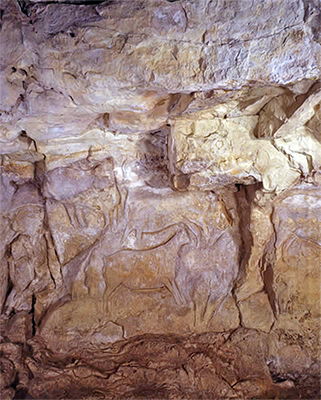
Zone Figurative 4, Panneau 6 - this is the original frieze in situ.
Photo: http://www.catalogue-roc-aux-sorciers.fr/objects/12/1/01000100/BDD-240a.jpg
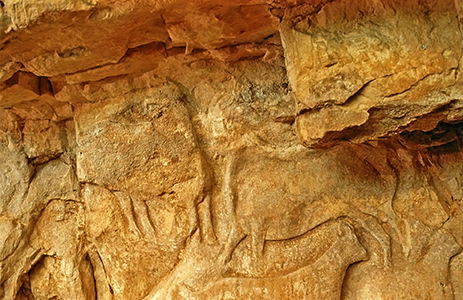
Zone Figurative 4, Panneau 6, abri Bourdois
Ibex sculpture, 'ibex turning its head', Bo1, BDD 251, shown at upper left in this image.
(This image also shows Bo2, BDD 254 on the right).
The support is oolithic Jurassic limestone, with the surface prepared by pecking to provide a smooth surface.
Length 980 mm, height at the shoulders (withers) 810 mm.
Length of head 247 mm, width of head 198 mm.
Support: wall, convex in the vertical plane, and flat on the horizontal plane.
Conservation state: good condition, but with calcification, concretions, freezing cupules, fractures, and ancient scaling.
The sculpture is in high relief, with low relief at the abrupt edge, and has traces of red pigment. The male ibex is seen in right profile. It stands straight up, with fixed legs. The head and the line of the back have many concretions. The tail is erect. The well preserved legs are detailed, and show the hock, pastern, fetlock, and cloven hoof. The end of the left hind leg is marked with a deep incision. An anneau (ring / 'jug handle' for attachment of a cord) was laid out on the buttocks. A red dot, PON1 is placed below the sculpture.
References: Iakovleva et Pinçon (1997), Iakovleva et Pinçon (1998),
Pinçon (2008)
Photo: © Geneviève Pinçon, ministère de la Culture, ill. Geneviève Pinçon, 1997
Text: translated by Don Hitchcock from http://www.catalogue-roc-aux-sorciers.fr
Source: http://www.catalogue-roc-aux-sorciers.fr/
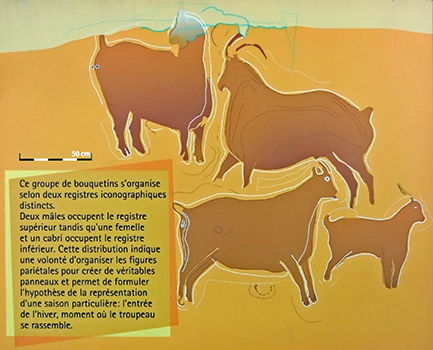
Zone Figurative 4, Panneau 6.
This group of ibex is organised into two distinct iconographic records.
Two males occupy the upper register while a female and an immature ibex occupy the lower register. This distribution indicates a willingness to organise the parietal figures to create real-life depictions and allows us to formulate the hypothesis that this is to illustrate a particular season: the beginning of winter when the flock gathers on the lowlands, after coming down from the mountains to winter pastures.
Photo: Don Hitchcock 2014
Source and text: Display, Centre d'interprétation de la frise magdalénienne du Roc-aux-Sorciers

Zone Figurative 4, Panneau 6.
This drawing shows clearly the elements of the frieze.
Photo: http://www.catalogue-roc-aux-sorciers.fr/objects/12/1/01000100/BDD-240b.jpg
Source: Premier panneau des bouquetins (BDD 240) : relevé.. © Geneviève Pinçon, ministère de la Culture
Illustration: Geneviève Pinçon, Ludmila Iakovleva, Oscar Fuentes, 1997-2004.

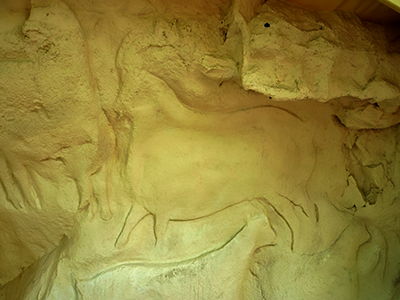
Zone Figurative 4, Panneau 6.
The two ibex are facing each other, possibly to illustrate the way that the males establish dominance during the rut.
Photo: Ralph Frenken 2015
Source: Display, Centre d'interprétation de la frise magdalénienne du Roc-aux-Sorciers

Zone Figurative 4, Panneau 6.
This ibex, whose head is heavily calcified, rotates its head to the back, as if he was the lookout posted to warn of danger.
Note, however, that another ibex (not shown in this drawing) faces him, possibly as part of the dominance testing by males during the rut.
Photo: Don Hitchcock 2014
Source and text: Display, Centre d'interprétation de la frise magdalénienne du Roc-aux-Sorciers
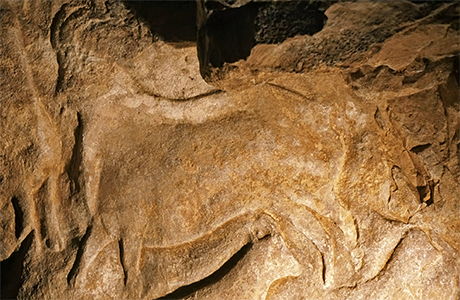
Zone Figurative 4, Panneau 6, abri Bourdois
Bo2, BDD 254
The support is oolithic Jurassic limestone, with the surface prepared by pecking to provide a smooth surface.
Length 1040 mm, height at the shoulders (withers) 800 mm.
Length of head 284 mm, width of head 198 mm, length of horn 27 mm.
Support: wall, convex in the vertical plane, and flat on the horizontal plane.
Conservation state: good condition, but with calcification, concretions, freezing cupules, fractures, and ancient scaling.
Commentary from Suzanne de Saint-Mathurin:
The enigmatic figure in the corner, after cleaning, appears to be the forequarters of a very large ibex. The head is rather spoiled by concretions, but the horns and muzzle are very visible, and the tongue pokes out. The body appears to be a bit 'hollow'. Under the hoof, there is another figure even more obscure. (Saturday, 23rd September 1950, excavation notes).
Gonneau continues at the same level, to expose the large ibex (recessed relief). The second leg appears. Below, the dorsal line of another beast. (Monday 20th August 1951, excavation notes).
Gonneau continues to lay bare the ibex. It is a beautiful sculpture, well modelled. (Tuesday, 21 August 1951, excavation notes).
Field notebook reference: 1950-09-23.
This is a bas relief sculpture with steep edges, completed with scraping. This male ibex is shown in right profile, and its outline is complete. The head bears all anatomical details such as well-developed horns and goatee beard. The mass of the body is displayed by an inverted relief. Its legs are detailed, with cloven hooves shown. The right front hoof was removed.
On the belly of the ibex, the volume is uneven and does not reflect the natural form of the animal. In fact, it shows the influence of the dorsal line of an older bison (An 1). The sculpture of the ibex was carried out at the expense of this older bison.
References: Iakovleva et Pinçon (1997), Iakovleva et Pinçon (1998)
Photo: © Geneviève Pinçon, ministère de la Culture, ill. Geneviève Pinçon, 2004
Text: translated by Don Hitchcock from http://www.catalogue-roc-aux-sorciers.fr
Source: http://www.catalogue-roc-aux-sorciers.fr/

Zone Figurative 4, Panneau 6.
In the desire to create a good design, the artist has placed the leg of the upper ibex so as not to interfere with the head of the female ibex located below. There is not one place where the sculptor has not intervened to create a harmonious composition.
Photo: Don Hitchcock 2014
Source and text: Display, Centre d'interprétation de la frise magdalénienne du Roc-aux-Sorciers
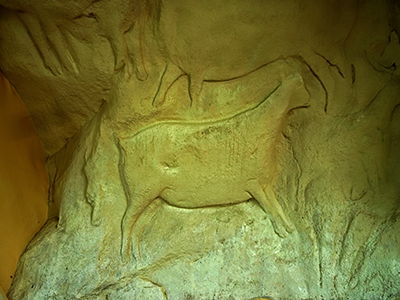
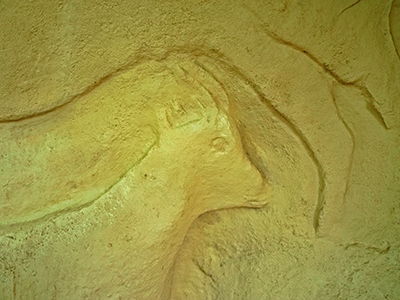
Zone Figurative 4, Panneau 6.
Young female ibex from Zone Figurative 4, Panneau 6.
Photo: Ralph Frenken 2015
Source and text: Display, Centre d'interprétation de la frise magdalénienne du Roc-aux-Sorciers

Zone Figurative 4, Panneau 6.
Under the young ibex may be seen the hindquarters of a bison, the head of an animal, and the legs of a woman.
These superpositions of figures are strong, both technically (engraving and sculpture) and thematically (bison, woman, then ibex). They reflect the successive recarving of the works by the Magdalenian artists.
Photo: Don Hitchcock 2014
Source and text: Display, Centre d'interprétation de la frise magdalénienne du Roc-aux-Sorciers
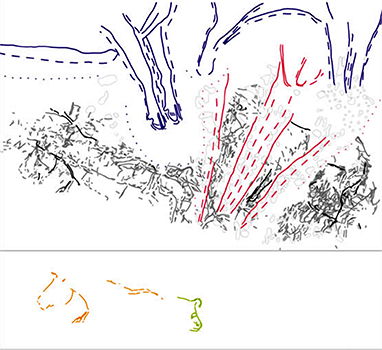
Zone Figurative 4, Panneau 6.
Drawing of the lower part of the lower register.
Note in particular the drawings which have been elucidated from a tangle of lines on the lower left of this panel.
Photo: Relevé des gravures du registre inférieur de la zone figurative 4 complété de relevés sélectifs (BDD 291)
© Geneviève Pinçon, ministère de la Culture, ill. Geneviève Pinçon, 1997.
Source: http://www.catalogue-roc-aux-sorciers.fr/html/12/selection/page_notice-ok.php?Ident=D&myPos=1&NoticeId=237
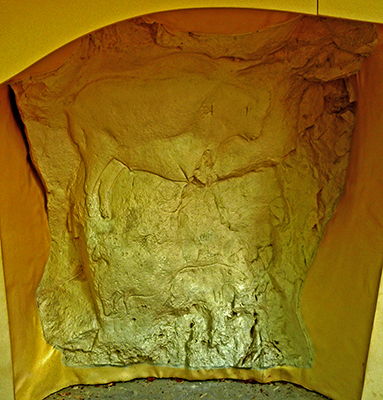
This is Zone Figurative 5, Panneau 7 on the complete catalog of the frieze.
This is the complete panel showing an ibex at the top, with other carvings superimposed, as well as other sculptures below it.
Photo: Ralph Frenken 2015
Source: Display, Centre d'interprétation de la frise magdalénienne du Roc-aux-Sorciers

Zone Figurative 4, Panneau 7, abri Bourdois
Bo6, BDD 272
carved ibex
wall art in situ (BO6) - BDD 272
The support is oolithic Jurassic limestone, with the surface prepared by pecking to provide a smooth surface.
Length 1110 mm, height at the shoulders (withers) 800 mm.
Length of head 235 mm, width of head 175 mm, ear length 45 mm, width of ear 22 mm, length of horn 50 mm.
Support: vertical wall.
Conservation state: fair condition, but with calcification, concretions, fractures, and scaling.
Commentary from Suzanne de Saint-Mathurin:
Suzanne continued to expose the Ibex, and behind it, a relief appears: probably the hindquarters of a bison. The ibex panel is superimposed on parts of a bison. (Friday, 7th September 1951, excavation notes)
In the morning, work continued to clean the new sculpture. (Saturday, 8th September, 1951, excavation notes)
The animal was revealed. It is an old ibex, with the front hooves missing (broken in ancient times). It seems to be falling. It has a pronounced abdomen. It is a male, with a beautiful head, magnificently designed eye and mouth. Diverging horns. (Thursday 13th September, 1951, excavation notes )
Field notebook reference: 1951-09-07
Technique: sculpture (high relief, low relief with a sharp edge, low relief with rounded edges), engraving, scraping, polishing, scraping.
The male ibex BO6, alone on the plaque, is seen in right profile. It is standing, slightly inclined, and the tongue is shown. The head, clearly shown, is finely made: the almond-shaped eye, bears a caruncula lacrimalis, the small, pink, globular nodule at the inner corner of the eye. The nostril is clearly illustrated, as well as the muzzle, lips, tongue, goatee beard, and a detailed ear. The curved horns follow a natural relief of the wall. The front legs are completely fractured.
The unrealistic massiveness of this ibex, with its withers shown as too angular, and the unusual shape of the area above the back, allows us to interpret it as formerly a sculpture of a bison. Note also areas highlighted by the sculptor (on the buttock, hip and abdomen) forming a convex line evoking the line of a horse's belly. This hypothesis is confirmed in its proportions in scaling with the "horse nodding", Ch2. This sculpture at present is read as an ibex, but it was probably previously an image of a bison and perhaps a horse.
References: Iakovleva et Pinçon (1997), Iakovleva et Pinçon (1998), Pinçon (2008)
Photo: © Geneviève Pinçon, ministère de la Culture, ill. Geneviève Pinçon, 1997
Text: translated by Don Hitchcock from http://www.catalogue-roc-aux-sorciers.fr
Source: http://www.catalogue-roc-aux-sorciers.fr/
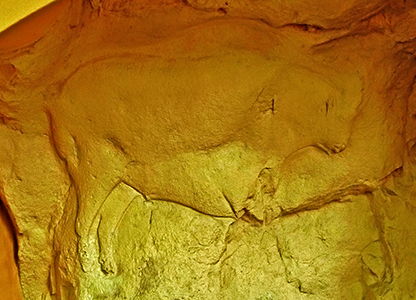
Zone Figurative 5, Panneau 7
This is a closeup of the ibex at the top of the panel.
Photo: Ralph Frenken 2015
Source: Display, Centre d'interprétation de la frise magdalénienne du Roc-aux-Sorciers
bdd-272aibexlookdownsorcsm 460 300
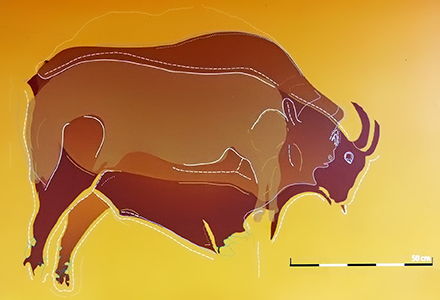
Zone Figurative 5, Panneau 7
Successive carvings leave unmistakeable traces on the wall. Here the outline of this ibex does not correspond to the morphology of the back. The hump indicates the outline of a bison. Furthermore, other forms appear under careful lighting conditions on the body of the animal, possibly showing the remains of the body of a horse.
We have superimposed outlines of two animals, a horse and a bison, conforming to the outlines shown elsewhere on the frieze, to illustrate these possibilities.
Photo: Don Hitchcock 2014
Source and text: Display, Centre d'interprétation de la frise magdalénienne du Roc-aux-Sorciers
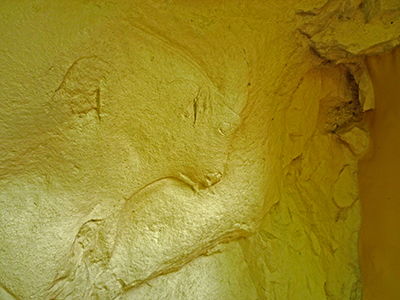
Zone Figurative 5, Panneau 7
Closeup of the ibex head.
Photo: Ralph Frenken 2015
Source: Display, Centre d'interprétation de la frise magdalénienne du Roc-aux-Sorciers


Zone Figurative 5, Panneau 7
A feline is shown here turning its back on a horse. Carnivores and herbivores seem to avoid each other in this composition.
Notice the subtlety of the details of the engravings.
Photo: Ralph Frenken 2015
Source and text: Display, Centre d'interprétation de la frise magdalénienne du Roc-aux-Sorciers
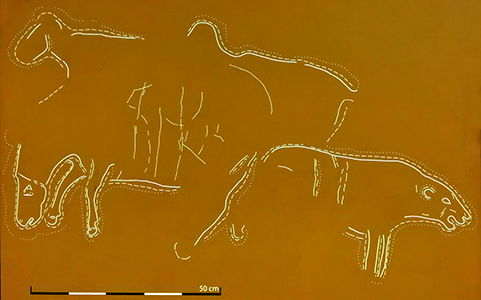
Zone Figurative 5, Panneau 7
From a technical point of view, the lower section is dominated by deep etching, while the upper section is made up of monumental sculptured representations.
Photo: Don Hitchcock 2014
Source and text: Display, Centre d'interprétation de la frise magdalénienne du Roc-aux-Sorciers
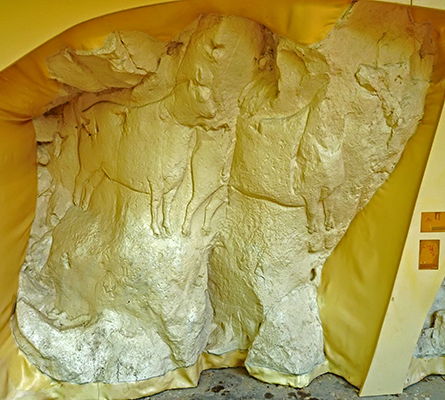
Zone Figurative 6, Panneau 8
Two male ibex. Below the left hand ibex is a human face..
Photo: Ralph Frenken 2015
Source: Display, Centre d'interprétation de la frise magdalénienne du Roc-aux-Sorciers
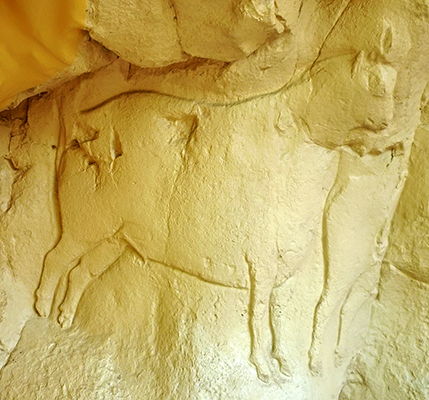
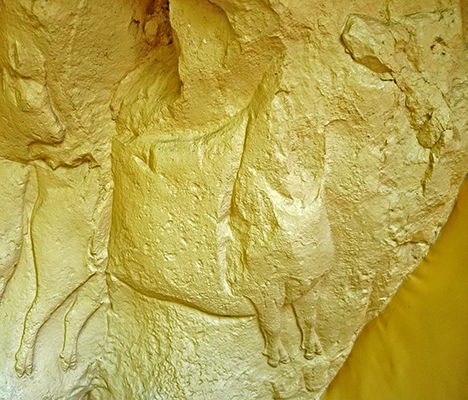
Zone Figurative 6, Panneau 8
The two ibex, close up.
Photo: Ralph Frenken 2015
Source: Display, Centre d'interprétation de la frise magdalénienne du Roc-aux-Sorciers

Zone Figurative 6, Panneau 8
On the croup of the ibex, there is an angular hole. Is it a sign, or the indication of an injury?
Photo: Don Hitchcock 2014
Source: Display, Centre d'interprétation de la frise magdalénienne du Roc-aux-Sorciers

Zone Figurative 6, Panneau 8
The head of the ibex on the right fell as a result of the spalling of part of the wall. Found among the archaeological remains during the excavation, it can be repositioned to complete the carving, as shown here.
Photo: Don Hitchcock 2014
Source and text: Display, Centre d'interprétation de la frise magdalénienne du Roc-aux-Sorciers
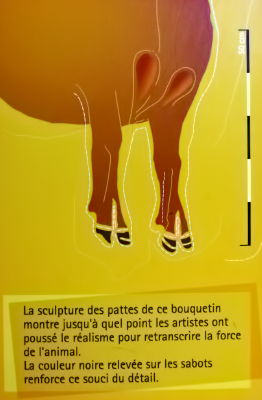
Zone Figurative 6, Panneau 8
The modelling of the legs of this ibex shows how the artists have enhanced reality to show the strength of the animal.
Photo: Don Hitchcock 2014
Source and text: Display, Centre d'interprétation de la frise magdalénienne du Roc-aux-Sorciers
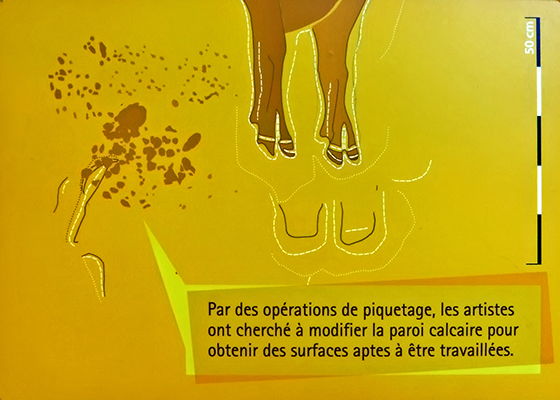
Zone Figurative 6, Panneau 8
By piquetage, pecking, the artists have sought to change the limestone wall to get obtain surfaces more amenable to creating the sculptures.
Photo: Don Hitchcock 2014
Source and text: Display, Centre d'interprétation de la frise magdalénienne du Roc-aux-Sorciers
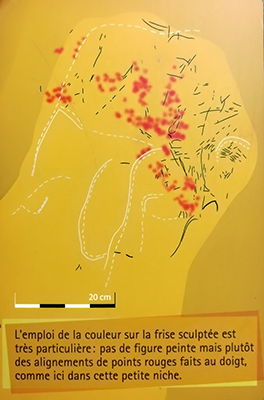
Zone Figurative 6, Panneau 8
The use of colour on the sculpted frieze is done in a particular way. The figures are not painted, but there are many lines of red dots made with the finger, as here in this little niche.
Photo: Don Hitchcock 2014
Source and text: Display, Centre d'interprétation de la frise magdalénienne du Roc-aux-Sorciers

Zone Figurative 6, Panneau 8
This human profile seems to smile at us. Very realistic, it is in the style of human representations of Roc-aux-Sorciers.
(I know of only one other human representation of this style at Roc-aux-Sorciers. It is, however, very much in the style of the hundreds of similar engravings at La Marche - Don )
Photo: Ralph Frenken 2015
Source and text: Display, Centre d'interprétation de la frise magdalénienne du Roc-aux-Sorciers
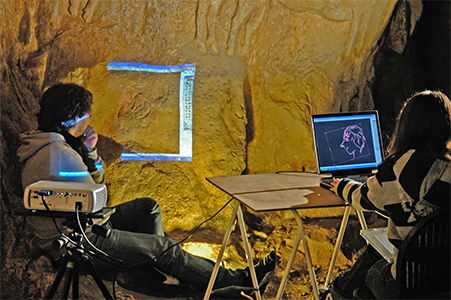
In this image, researchers have superimposed a similar head from La Marche as a computer projected line drawing over the top of the head at Roc aux Sorciers, and are in the process of rotating and reducing the projected image to the size and orientation of the head carved in the wall, in order to compare the two for style and technique.
Photo: © Pinçon
Source: http://www.sculpture.prehistoire.culture.fr/en/contenu/research.html

Another image of researchers at the site, from the same photographic session.
Photo: © Pinçon
Source: http://www.sculpture.prehistoire.culture.fr/en/contenu/research.html

Zone Figurative 6, Panneau 8
The image appears by itself, apparently unrelated to the main panel.
Photo: Ralph Frenken 2015
Source: Display, Centre d'interprétation de la frise magdalénienne du Roc-aux-Sorciers
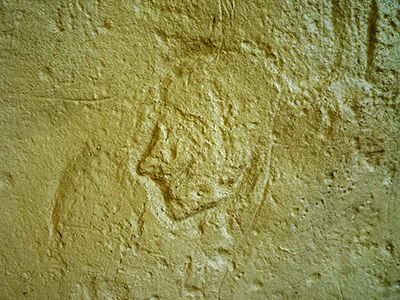
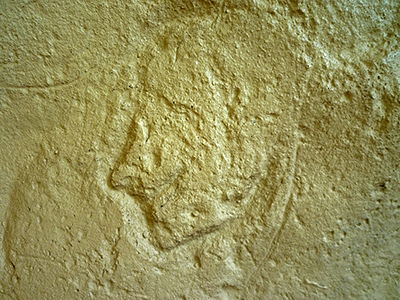
Zone Figurative 6, Panneau 8
Close up of the human head representation.
Photo: Ralph Frenken 2015
Source: Display, Centre d'interprétation de la frise magdalénienne du Roc-aux-Sorciers
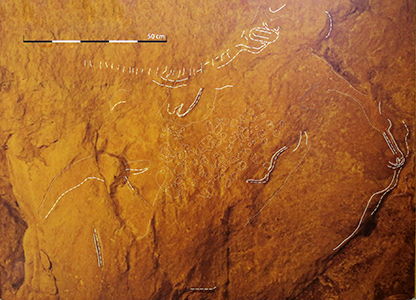
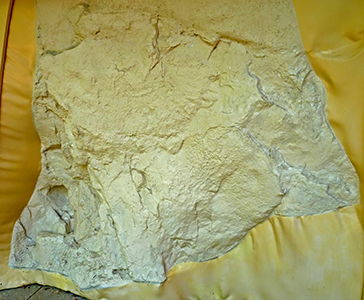
Zone Figurative 7
On this section of the frieze we can see very faint remnants of partially destroyed sculptures. This one shows, perhaps, parts of a sculpted bison.
Original photo (left): ©RMN/©Thierry Ollivier
Source and text: Display, Centre d'interprétation de la frise magdalénienne du Roc-aux-Sorciers
Photo: (right) Ralph Frenken 2015
Source: Display, Centre d'interprétation de la frise magdalénienne du Roc-aux-Sorciers
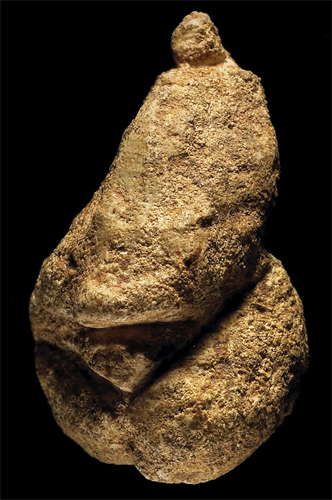

Venus of Roc-aux-Sorciers, (left) three quarters view from the left.
Venus of Roc-aux-Sorciers, (right) back view
The statuette has been sculpted from a small block of limestone and was discovered under a rock pile in the Cave Taillebourg.
Photo: MAN 83797 (BDD 134) © RMN, MAN, ill. Thierry Ollivier, 2007
Source and text: http://www.catalogue-roc-aux-sorciers.fr/

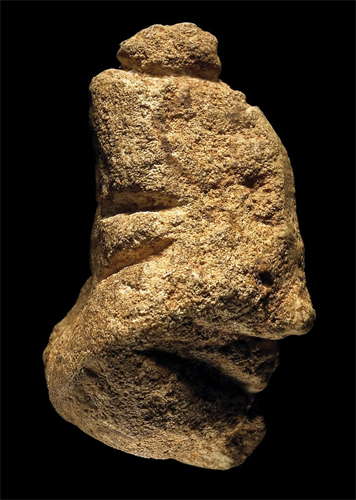
Venus of Roc-aux-Sorciers, (left) front view.
Venus of Roc-aux-Sorciers, (right) right profile.
This female figure in the round is complete and shown from head to feet. It measures 33 mm tall, making it one of the smallest statues known in the Palaeolithic. It has been clearly delineated, with deep and wide incisions, the head is relatively small, the pubic triangle is perfectly marked, and it has broad buttocks and large thighs. The carving of the pubis reveals a rather angular stomach. The only notable details are the arms, shown bent and resting on the belly. This feminine figure, a truly movable sculpture, has a common connection with other female figures in the round, the largest group among the Palaeolithic female representations. It remains, however, to our knowledge, unique in its attitude, its shape, its details and dimensions.
Photo: MAN 83797 (BDD 134) © RMN, MAN, ill. Thierry Ollivier, 2007
Source and text: http://www.catalogue-roc-aux-sorciers.fr/
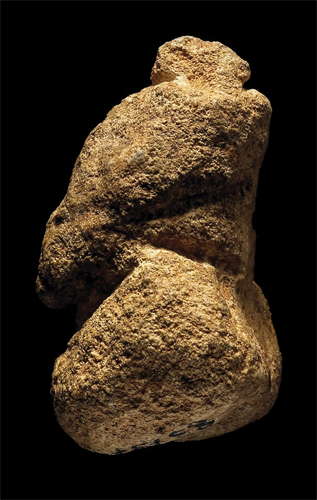
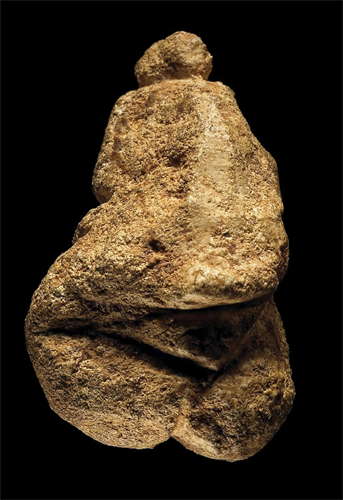
Venus of Roc-aux-Sorciers, (left) left profile
Venus of Roc-aux-Sorciers, (right) right front view.
Photo: MAN 83797 (BDD 134) © RMN, MAN, ill. Thierry Ollivier, 2007
Source: http://www.catalogue-roc-aux-sorciers.fr/
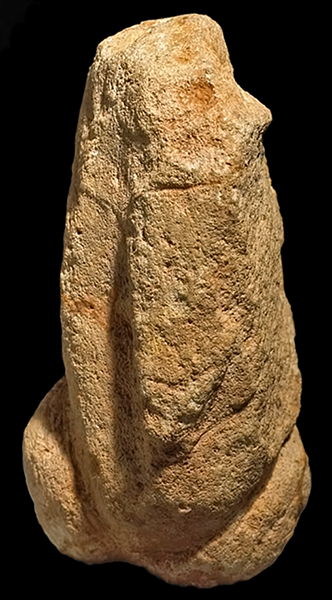
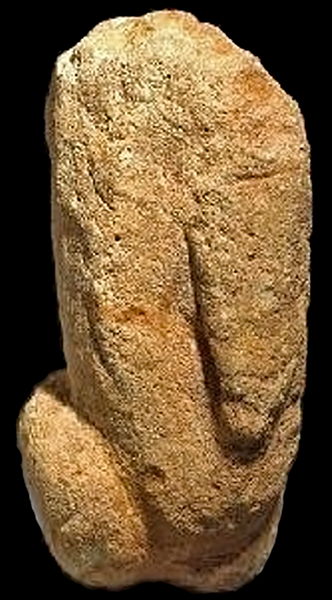
Venus of Roc-aux-Sorciers - second Venus. Height is 75 mm, much larger than the one shown above.
This venus appears to be made of the same lithic material as the first.
Catalog: MAN83798
Photo: © RMN, MAN, ill. Thierry Ollivier, 2007
Source: http://www.nihilum.republika.pl/W_Roc_aux_Sorciers_03.htm, probably originally from http://www.catalogue-roc-aux-sorciers.fr/
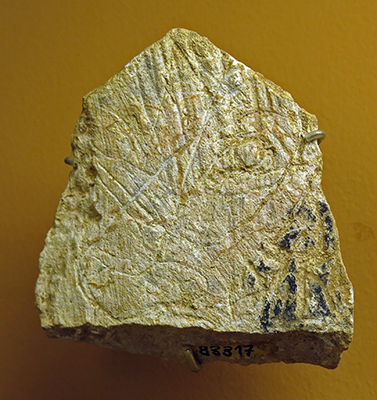
Plaquette de calcaire gravée figurant une tête de renne.
Limestone block showing the head of a reindeer.
Photo: Don Hitchcock 2014
Source: Original, Musée d'Archéologie Nationale et Domaine, St-Germain-en-Laye

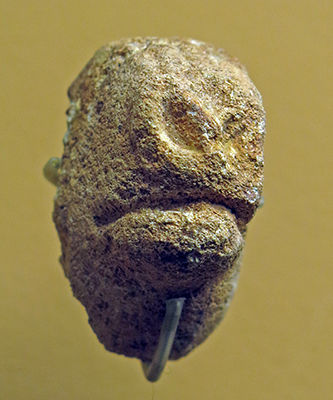
Museau de cheval sculptée en calcaire.
Nose of a horse sculpted in limestone.
Photo: Don Hitchcock 2014
Source: Original, Musée d'Archéologie Nationale et Domaine, St-Germain-en-Laye

A spear point called 'Lussac-Angles', a regional cultural marker.
These are made of reindeer antler, and typically have a single bevel, and often with a groove on one or both sides.
Original photo: ©RMN/©Thierry Ollivier
Source and text: Display, Centre d'interprétation de la frise magdalénienne du Roc-aux-Sorciers Additional text: Delage (2012)
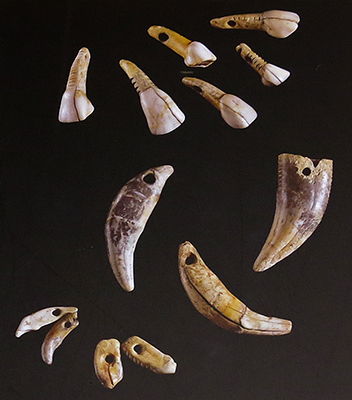
Drilled and decorated teeth of various animals.
Original photo: ©RMN/©Thierry Ollivier
Source and text: Display, Centre d'interprétation de la frise magdalénienne du Roc-aux-Sorciers

Beads of mammoth ivory.
Original photo: ©RMN/©Thierry Ollivier
Source and text: Display, Centre d'interprétation de la frise magdalénienne du Roc-aux-Sorciers
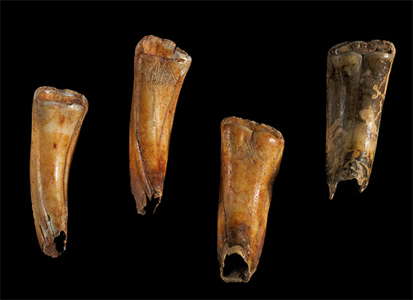
Incisors of horses whose decoration includes cross hatching within a triangle. A total of 22 foal incisors were studied, of which 18 are from the collection of St. Mathurin , kept at the Musée d'Archéologie Nationale (MAN) and 4 from the excavations of Lucien Rousseau.
Within this series, 20 have etchings on the lingual (touching the tongue) surface of the tooth, engravings whose graphic units break down into 12 triangles, 7 trapezoids and a figure composed of two parallel lines. 7 of these pieces also have incisions, more or less deep, variable in number, located on the edges of the tooth.
The two pieces completing the series have incisions only on the side edges. The labial (touching the lips or cheek) surfaces show no engraving.
Photo: © NMR, ill. Thierry Ollivier
Source and translated text: http://www.catalogue-roc-aux-sorciers.fr/html/12/collection/2_4_3.html
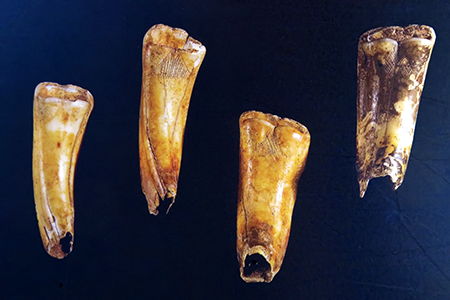
Another version of the photograph above.
Original photo: ©RMN/©Thierry Ollivier
Source: Display, Centre d'interprétation de la frise magdalénienne du Roc-aux-Sorciers
Geometric figures etched on the lingual surface are engraved with a very carefully made fine grid, with the lines forming a kind of tight weave or cross hatching. Indeed, one can count on one of the pieces up to 35 intersecting lines within one square centimetre. Note that the sides of the figure are more deeply cut, probably to better accentuate the shape and enhance its filling. The top is never enclosed by a line, the grid acts as the boundary, and the tip of the triangle or the small base of trapezium are lost in the dental groove. Note that a deposit of red ochre remains in the grid of certain teeth.
These objects remain a feature of the Magdalenian in Poitou (a province of west-central France), which can lead one to consider the notion of territory.
Indeed, except for sites of Roc-aux-Sorciers and La Marche which provided most of these pieces, a few isolated teeth have been reported, particularly in Vienne, Lussac-les-Châteaux, grotte des Fadets 2 and Charente Montgaudier, abri Gaudry 3 . This suggests that these engraved objects, manufactured in substantial quantities (more than a hundred) in a restricted territory, had not apparently been the subject of trade or for distribution outside the region, and had a very specific locality and purpose.
About etched incisors, some authors have evoked their use as jewellery, especially because of the deep incisions made on the lateral edges that could have been used to suspend them by tightly wrapping the tooth at that point with a cord. Without categorically refuting this proposal, it seems difficult to envisage such use by the variety of the incisions as well as their number and position on the pieces. Moreover, the absence of perforation, certainly possible to achieve, allows us to distinguish very clearly these engraved teeth from other types of perforated, suspended teeth.
We should recall the symbolic aspect of these objects which necessarily reflects the creativity and spirituality of these Magdalenian groups.
Indeed, the engraving of the cross hatched triangle evokes in a realistic fashion pubic hair, especially since the bottom of the pubic hair area stops just before the navicular fossa above the entry to the vagina. As well, the foals' teeth have a naturally morphology, if not similar, at least suggestive of this, which would have been exploited by the Magdalenians. We should not forget that at Roc-aux-Sorciers, female figures are very present, both on the walls and in the form of statuettes in the same level of occupation.
Translated text: http://www.catalogue-roc-aux-sorciers.fr/html/12/collection/2_4_3.html
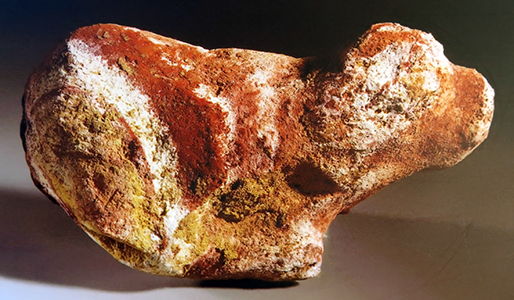
Animal sculpture.
Original photo: ©RMN/©Thierry Ollivier
Source: Display, Centre d'interprétation de la frise magdalénienne du Roc-aux-Sorciers
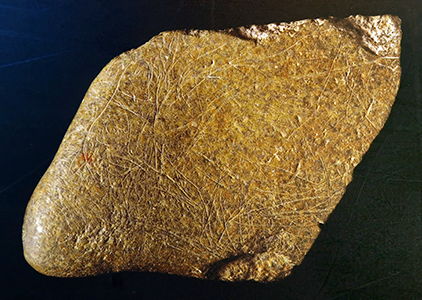
Animal engraving on a pebble.
Original photo: ©RMN/©Thierry Ollivier
Source: Display, Centre d'interprétation de la frise magdalénienne du Roc-aux-Sorciers
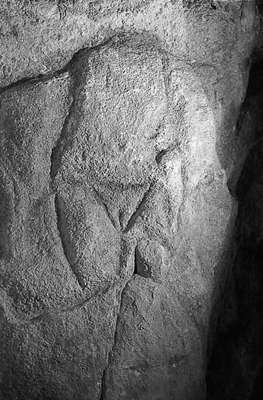
Venus 4 from Roc-aux-Sorciers, Upper Paleolithic ca 14 000 BP.
Photo: http://ushishir.tumblr.com/post/674127014/venus-4-from-le-roc-aux-sorciers-cave-upper
In addition, two types of wear observed on these pieces caught our attention because they might suggest a possible function as a tool: they are the thinning by abrasion of the apical zone and the labial face, which could be caused by the wear of binding to a support, as well as other wear and polish observed on the eating area of the lingual surface, which can sometimes destroy some of the engraving, and this could be the result of use.
Only further study would help to form a hypothesis. It should be noted that the fractures observed on some teeth can not be attributed to the use of these objects as a tool.
The study of the etched incisors of Roc-aux-Sorciers highlights the homogeneity that exists with the hundred pieces from the site of La Marche and it is a coherent set of objects most likely involved the same intent.
Certainly, the image of woman with this stylised representation gives them a symbolic value. But beyond the mere object of pieces of art, it is likely that other motivations led to their development.
The incredible attention to detail, and the dexterity required for the implementation of these engravings also link to the choice of support which often determines their dimensions and dictates the technical difficulties that the creator faces. In this case, the choice of a foal incisor as the medium of expression is probably not insignificant.
Translated text: http://www.catalogue-roc-aux-sorciers.fr/html/12/collection/2_4_3.html
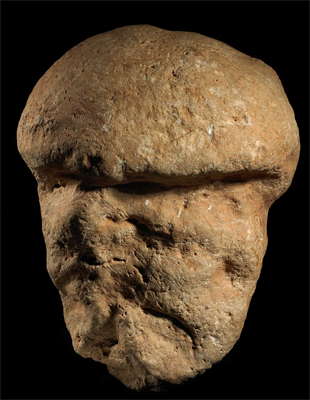
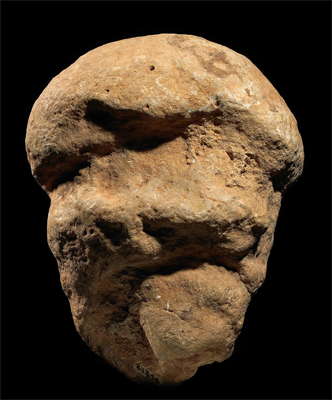
Human head carved on fossil madrepore, from Le Roc-aux-Sorciers, abri Bourdois.
(Madrepore ('mother of pores') is a genus of stony corals, often found forming reefs or islands in tropical locations. The names Madrepore and Madreporaria were formerly applied universally to any stony coral of the family Scleractinia - Don )
Dimensions: 200 mm long, 120 mm wide, in good condition.
Provenance: Collection Saint-Mathurin.
Comment by Suzanne de Saint-Mathurin:'Some colonies of stony corals by a skull often remind their curves and calciferous region that simulates a helmet. Protrusions and cavities, and the elongated oval shape of the polyp accentuate the resemblance to a flayed human head'
(de Saint-Mathurin 1974)
Decor Technique: engraving, black paint.
This piece, quite evocative in its natural form, was used to represent a human head in the round. The artist has been able to use the perfectly pleated natural madrepore fossil, and the shadows that mark shape details. The rounded morphology of the upper part serves to highlight a hairstyle. The face is based on surface irregularities, with cheekbones, and a long narrow nose. The artist has only drawn the two almond-shaped eyes with the eyelid, the right nostril and around the mouth.
The human likeness is visible from the front or the side, and the artist was able to deal with subtlety with the natural shape and anatomical details he chose to draw. Formally close to the human face, we have here a representation of a human face with a large cap on the head.
References:
Delporte (1989)
de Saint-Mathurin (1973)
de Saint-Mathurin (1974)
Pinçon (2005)
Photo: MAN 83314 - DB 133: © RMN, MAN, ill. Thierry Ollivier, 2007.
Source: http://www.catalogue-roc-aux-sorciers.fr/
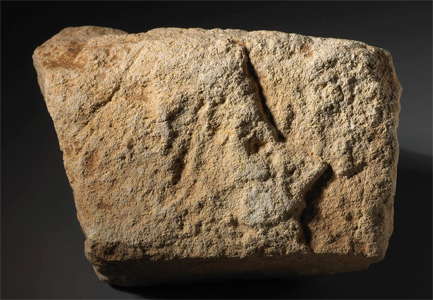
Human face, Le Roc-aux-Sorciers, cave Taillebourg.
Origin: Le Roc-aux-Sorciers, cave Taillebourg; Layer: TCD (Middle Magdalenien ); Sector: f45.
Limestone
Length 64 mm, width 54 mm.
Conservation status: limestone plate; middling condition; scaling, friable limestone.
Provenance: Collection Saint-Mathurin
Found in 1964.
Decor Technique: Bas relief.
This item has an etched profile and slightly modeled image of a human looking to the right. The subject occupies the entire surface of the plaque, and no indication of the engravings being interrupted by fractures, which is why we categorise it as an object of mobile art and not a fragment from the collapsed wall.
The nose, face and eyes are in low relief. The nasal line has a relief of about 5 mm. Around the curvature of the nose, the thickness tends to be reduced, then it becomes stronger on the face, but does not exceed 5 mm. A large area of flattening was carried out before this relief, which has improved the depiction. The profile becomes more marked when seen with an obliquely angled light. The area around the representation of the mouth also seems to have been carved to better show relief. The surface is very marked and eroded by time, so that interpreting the man-made features is not easy. By lighting the piece from different angles and different intensities, better views are obtained.
The Magdalenians certainly played with lighting in order to display with more effect an image, or to create a particular sensation. This type of sculpture is well suited to this type of approach. With these variations in lighting, we see a good profile and especially the fronto-nasal line. The Magdalenian artist seems to have given special importance to this area and has the means to express what he wanted to achieve. From an iconographic point of view, the eye also appears to be an important element.
Comment
This plaque is a small piece of oolitic limestone. It was found in 1964 in the Cave Taillebourg, near a large rock from the ceiling (F45), beneath sculptures of bison mutilated by the impact of the fall. The plate rested face down on the ground, over the hearth of the D level, underlying the sandy layer. Near the plate were found a horse hyoid bone and short spears with a long bevel and a central groove or rainure, pierced shells extracted from the fossilised beds of the Cainozoic of Touraine, a lamp, and the incisors of two young horses, adorned on their labial surface with a checkerboard grid. The surface of the plaque is marked by small numbers of chips that all appear to be due to natural erosion of the limestone, which is very friable.
References:
Delporte (1989)
de Saint-Mathurin (1973)
Pinçon (2005)
Photo: Plaquette gravée d’un profil humain MAN 83308 (BDD 132)
© RMN, MAN, ill. Thierry Ollivier, 2007.
Text: Oscar Fuentes, Geneviève Pinçon
Dernière modification de la notice : 2008-04-18
© Réunion des musées nationaux – 2009
Source: http://www.catalogue-roc-aux-sorciers.fr/

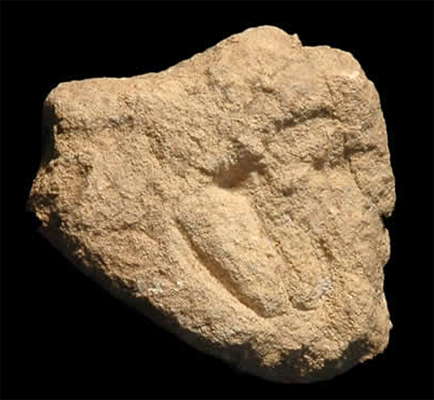
Vulva, Le Roc-aux-Sorciers, cave Taillebourg.
Material and technique: Limestone.
Length: 79 mm; width : 90 mm; thickness : 30 mm.
Conservation status: Limestone block with shaped edges, old fractures.
Provenance: Rousseau Collection.
Decor technique: Sculpture, wide and deep engraving.
Centred on the surface of the block with shaped edges, the engravings are very deep and wide in a triangular pattern marked by a midline incision suggesting a pubic triangle. A cupule interrupts the line of the upper edge of the triangle. The line indicating the vulva extends beyond the contour of the triangle and reaches the edge of the block. The right side of the deep carving is not straight and brings an ambiguity of reading if you turn the object to the left.
Comment: This object is the only sculpted element identified by Lucien Rousseau during his excavations.
Photo: Bloc sculpté (BDD 344): vulva
© Jacques Lemounier, ill. Alain Maulny, 2008.
Text: Geneviève Pinçon Dernière modification de la notice : 2008-07-18
© Réunion des musées nationaux – 2009
Source: http://www.catalogue-roc-aux-sorciers.fr/
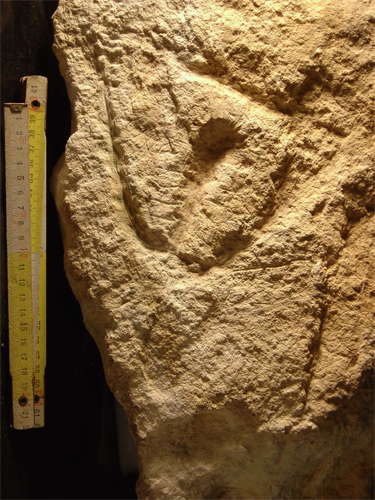
Vulva, Le Roc-aux-Sorciers, cave Taillebourg.
Bloc R37, BDD 123, Face B.
Material: Jurassic oolitic limestone, good condition.
Length 77 cm, Width 39 cm, width 35 cm.
Collection Saint-Mathurin.
Photo and text: © MAN, Geneviève Pinçon, ill. Geneviève Pinçon, 2004.
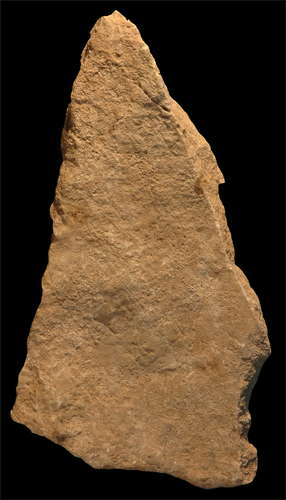
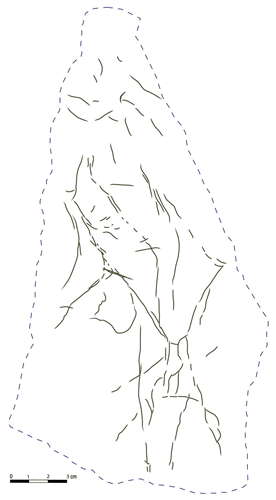
Le Roc-aux-Sorciers, cave Taillebourg.
Limestone block.
Length : 270 mm ; width : 150 mm ; thickness : 70 mm.
State of conservation: fragment of limestone; old fissures, fractures.
Provenance: Collection Rousseau.
All features indicated on this limestone fragment are difficult to interpret. Taking the piece vertically (tip of the block up), we can offer this interpretation:
It could be a headless human figure. You can follow the trunk with attached arms, left arm along the body, the right arm extended forward, and both legs slightly apart, between which a penis is indicated.
Technique: engraving.
Photo: Bloc gravé (BDD 346) © Jacques Lemounier, ill. Alain Maulny, 2008.
Text: Geneviève Pinçon, Aurélie Abgrall, Camille Bourdier, Oscar Fuentes
Dernière modification de la notice : 2008-04-04
© Réunion des musées nationaux – 2009
Source: http://www.catalogue-roc-aux-sorciers.fr/
References:
Pinçon G. et al. (1999)
Pinçon G. et al. (2004)
Source: http://www.catalogue-roc-aux-sorciers.fr/

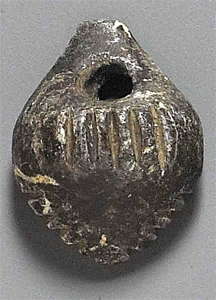
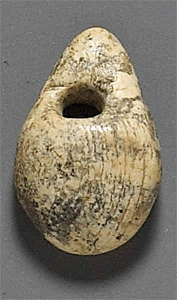
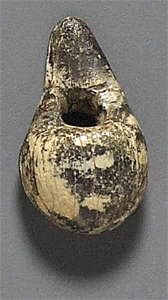
Le Roc-aux-Sorciers, cave Taillebourg.
These beads are known from this site as 'stomach beads' presumably because of their shape. They are very similar to the 'basket beads' from the Castel-Merle area of the Vézère region, and presumably were made in the same way, see below.
(far left) Stomach bead MAN 86828 45 — BDD 45
Mammoth ivory, good condition, transverse sawing technique unidentified, followed by bending, shaping and probably by scraping.
Dimensions: Length from close end to where bead becomes thinner: 7.5 mm, maximum length 15 mm, maximum width 13 mm, minimum width 5 mm, maximum thickness 10.5 mm, minimum thickness 3 mm
The source gives: Long. prox.: 0,75 cm; Long. max.: 1,5 cm; L. max.: 1,3 cm; L. à la perforation: non mesurable; L. min.: 0,5 cm; Ép. max.: 1,05 cm; Ép. à la perforation: non mesurable; Ép. min.: 0,3 cm.
Collection Saint-Mathurin, ref. box 24.
Relatively shiny piece, not perforated or decorated.
(centre left) Stomach bead MAN 86828 46 — BDD 46 Layer: TCC/TCD (Middle Magdalanian); sector: locus 57 passage.
Mammoth ivory, perforated
Dimensions: length from closer end to the perforation, 10 mm, maximum length 22 mm, maximum width 16.5 mm, width at the perforation 13 mm, minimum width 5 mm, maximum thickness 9.5 mm, thickness at the perforation 3.5 mm, minimum thickness 2 mm.
The source gives: Long. prox.: 1 cm; Long. max.: 2,2 cm; L. max.: 1,65 cm; L. à la perforation: 1,3 cm ; L. min.: 0,5 cm ; Ép. max.: 0,95 cm; Ép. à la perforation: 0,35 cm; Ép. min.: 0,2 cm.
Collection Saint-Mathurin
Longitudinal and transverse incisions.
The entire surface of this piece has a lustrous, black aspect (it has been impregnated with manganese dioxide); perforation off-centre.
(centre right) Stomach bead MAN 86828 47 — BDD 47 Layer: TCD (Middle Magdalanian); sector: 63
Mammoth ivory, perforated, good condition.
Dimensions: length from closer end to the perforation, 8 mm, maximum length 18 mm, maximum width 11.5 mm, width at the perforation 9 mm, minimum width 5 mm, maximum thickness 6 mm, thickness at the perforation 3 mm, minimum thickness 2.5 mm.
The source gives: Long. prox. : 0,8 cm ; Long. max. : 1,8 cm ; L. max. : 1,15 cm ; L. à la perforation : 0,9 cm ; L. min. : 0,5 cm ; Ép. max. : 0,6 cm ; Ép. à la perforation : 0,3 cm ; Ép. min. : 0,25 cm.
Collection Saint-Mathurin
The entire surface of the piece has a lustrous aspect, strong wear at the perforation shows that it was attached at the side.
(far right) Stomach bead MAN 86828 49 — BDD 49 Layer: unknown
Mammoth ivory, perforated, good condition.
Dimensions: length from closer end to the perforation, 9 mm, length from the tip to the perforation 7 mm, total length 17.5 mm
Dimensions: length from closer end to the perforation, 9 mm, maximum length 17.5 mm, maximum width 10 mm, width at the perforation 7 mm, minimum width 4 mm, maximum thickness 6 mm, thickness at the perforation 2.5 mm, minimum thickness 2 mm.
The source gives: Long. prox. : 0,9 cm ; Long. max. : 1,75 cm ; L. max. : 1 cm ; L. à la perforation : 0,7 cm ; L. min. : 0,4 cm ; Ép. max. : 0,6 cm ; Ép. à la perforation : 0,25 cm ; Ép. min. : 0,2 cm.
Collection Saint-Mathurin
The entire surface of the workpiece is lustrous; the morphology of the piece mimics that of a red deer tooth, slightly off-centre perforation.
© RMN, MAN, ill. Thierry Ollivier, 2007.
Source: http://www.catalogue-roc-aux-sorciers.fr/
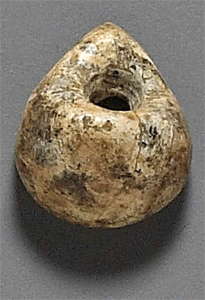
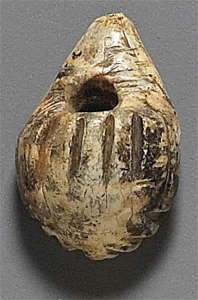
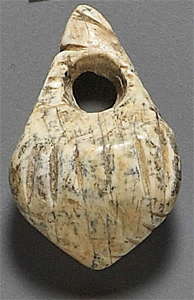
Le Roc-aux-Sorciers, cave Taillebourg.
These beads are known from this site as 'stomach beads' presumably because of their shape. They are very similar to the 'basket beads' from the Castanet area of the Vézère region, and presumably were made in the same way, see below.
(left) Stomach bead MAN 86828 50 — BDD 50
Mammoth ivory, good condition.
Dimensions: length from closer end to the perforation, 7.5 mm, maximum length 14 mm, maximum width 11.5 mm, width at the perforation 9.5 mm, maximum thickness 6 mm, thickness at the perforation 2.5 mm, minimum thickness 2.5 mm.
The source gives: Long. prox. : 0,75 cm ; Long. max. : 1,4 cm ; L. max. : 1,15 cm ; L. à la perforation : 0,95 cm ; L. min. : non mesurable ; Ép. max. : 0,6 cm ; Ép. à la perforation : 0,25 cm ; Ép. min. : 0,25 cm.
Collection Saint-Mathurin
Excavation catalogue entry: 1949-09-30.
The entire surface of the piece is lustrous. The morphology of the piece mimics that of a red deer tooth.
(centre) Stomach bead MAN 86828 51 — BDD 51 Layer: TCC (Middle Magdalanian); sector: locus 57.
Mammoth ivory, good condition.
Dimensions: length from closer end to the perforation, 10.5 mm, maximum length 20 mm, maximum width 13 mm, width at the perforation 11 mm, minimum width 4.5 mm, maximum thickness 8.5 mm, thickness at the perforation 4 mm, minimum thickness 2 mm.
The source gives: Long. prox. : 1,05 cm ; Long. max. : 2 cm ; L. max. : 1,3 cm ; L. à la perforation : 1,1 cm ; L. min. : 0,45 cm ; Ép. max. : 0,85 cm ; Ép. à la perforation : 0,4 cm ; Ép. min. : 0,2 cm.
Collection Saint-Mathurin.
Décor Technique : longiturdinal and transverse incision.
Face a, zone 1: a series of four short longitudinal incisions and relatively deep.
Face a, zone 2: 2 sets of three transverse incisions short and relatively deep, the two series of incisions facing each other.
The entire surface of the piece is lustrous. Residues of ochre in the incisions of the decorations,
wormlike carvings on the b side, slightly off-centre perforation.
(right) Stomach bead MAN 86828 52— BDD 52, Layer: TCC (Middle Magdalanian); sector: locus 57.
Mammoth ivory, perforated, good condition.
Dimensions: length from closer end to the perforation, 11 mm, maximum length 15 mm, maximum width 15 mm, width at the perforation 9 mm, minimum width 4 mm, maximum thickness 8 mm, thickness at the perforation 3 mm, minimum thickness 3 mm.
The source gives: Long. prox. : 1,1 cm ; Long. max. : 2,3 cm ; L. max. : 1,5 cm ; L. à la perforation : 0,9 cm ; L. min. : 0,4 cm ; Ép. max. : 0,8 cm ; Ép. à la perforation : 0,3 cm ; Ép. min. : 0,3 cm.
Collection Saint-Mathurin
Décor Technique : longitudinal and transverse incisions.
Face a, zone 1: a series of six short and relatively deep incisions
Face a, zone 2: a series of four short and relatively deep incisions, on only one edge.
The piece is lustrous over the whole surface.
© RMN, MAN, ill. Thierry Ollivier, 2007.
Source: http://www.catalogue-roc-aux-sorciers.fr/
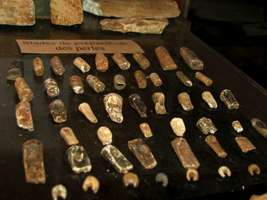
Stages in the making of 'basket-shaped' or 'stomach' beads, probably from Abri Blanchard and Abri Castanet, and discovered by M. Marcel Castanet.
So-called basket-shaped beads were first recognized by Marcel Castanet (see photograph below) at Abri Blanchard in 1909 (Didon 1911; 1912; Delluc & Delluc 1981) This discovery prompted Castanet, a farmer at Sergeac in the Dordogne, to wet-sieve all of the sediments from Blanchard (more than 200 such beads), as well as the proximate sites of Castanet (Peyrony 1935) and La Souquette (White 1989). Also recovered from the sieves were hundreds of unfinished beads and production debris, allowing the reconstruction of a complex and ingenious chaîne opératoire for bead production. Experiments suggest that from one to three hours of labor per bead are required using this process.
Text: White (2007)
Photo: Don Hitchcock 2008
Source: Originals, Musée de la préhistoire à Sergeac
Techniques for producing Aurignacian ivory and stone beads vary from one European region to the next. In France, the most common form, represented by more than 1000 specimens and dated to between 33 000 and 32 000 years ago, is 'basket-shaped.' They were created from pencil-like rods of ivory or soapstone that were then circuminscribed and snapped into cylindrical blanks from one to two centimetres in length. These were then bilaterally thinned at one end to form a sort of stem. A perforation was then created at the junction of the stem and the unaltered end. This was done by gouging from each side, rather than by rotational drilling.
These rough-outs were then ground and polished into their final basket-shaped form using hematite as an abrasive.
Text above: http://www.insticeagestudies.com/library/representation-technology-and-society-before-lascaux.shtml

I find this photograph of M. Marcel Castanet sieving deposits very evocative. It is very well composed and executed. His work was ground-breaking in the understanding of "basket shaped" beads.
Photo: Castanet (2006)
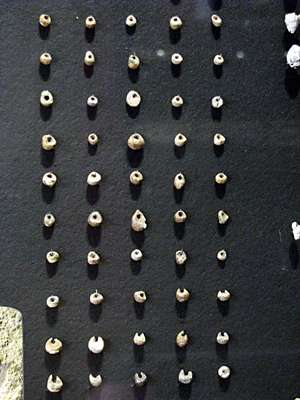
'basket-shaped' or 'stomach' beads from Abri Castanet.
Photo: Don Hitchcock 2008
Source: Originals on display at Le Musée National de Préhistoire, Les Eyzies-de-Tayac

The five main production stages for the manufacture of Aurignacian basket-shaped beads. Those pictured are from Abri Blanchard, the type-site for such objects.
Stage 1: creation of cylindrical, pencil-like rods of talc/chlorite or of ivory.
Stage 2: circumincision of these rods into segments of 1 to 2 cm long, which are then snapped off the longer rod.
Stage 3: bifacial thinning of one end of the detached cylinders to create a kind of stem at one end and a bulb at the other.
Stage 4: perforation by bifacial gouging or rotational drilling at the junction of the stem and the bulb.
Stage 5: reduction of the stage 4 roughout by coarse abrasion and eventually by fine polishing in order to obtain the characteristic basket shape.
Photo and text: White (2007)
(Note that the beads from Roc-aux-Sorciers have been made with the hole further away from the near end than those from Abri Castanet and Abri Blanchard, and have then been further shaped to create either a teardrop shaped bead, or one which closely resembles a red deer tooth - Don )
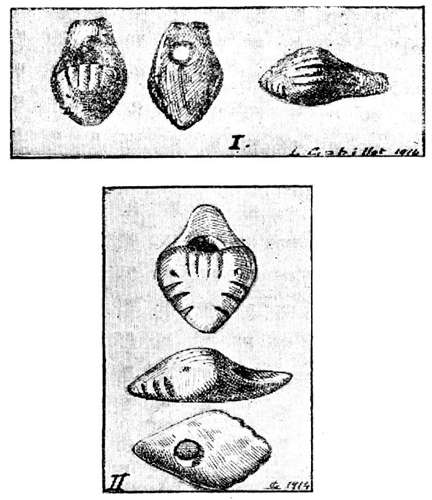
Various pendants from Vienne.
1 - Magdalenian pendant from la Grotte des Fadets (Lussac) Collection Tartarin.
2 - Magdalenian pendant from la Grotte des Fadets (Lussac) Collection Morel.
Photo and text: Gobillot (1919)
Le Magdalénien dans la Vienne. Découverte et fouille d'un gisement du Magdalénien à Angles-sur-l'Anglin (Vienne)
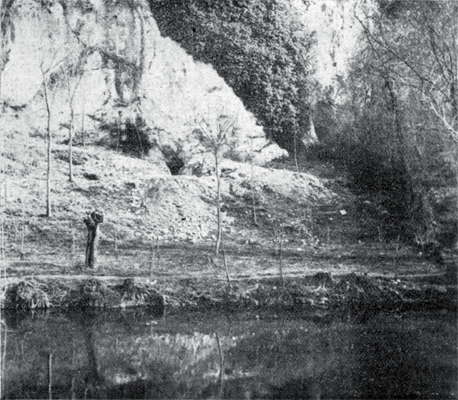
General view of the cave, the Cave à Lucien Jacob, at Angles-sur-L'Anglin, now known as Cave Taillebourg
Photo: Rousseau (1933)
On 24 October 1929, I communicated to the Société Préhistorique Française a short note, stating the discovery I had made to date in Vienne (the northernmost département of the Poitou-Charentes region of France - Don ), of a new deposit of the Magdalenian.
Since that time, I continued the excavations that I had begun, and I believe I now have sufficient documentation to be able to give a more complete account. That is the purpose of the study that I present today with the hope of stimulating further research in an area which has been little explored, but that seems particularly interesting.
Indeed, if we consult a map of Vienne we can see that almost all the rivers which cross this départemente, make their passage through the country in a direction roughly south-north, and following their course, we note that they have dug deep valleys into the limestone country, lined in many places by high cliffs, where caves abound.
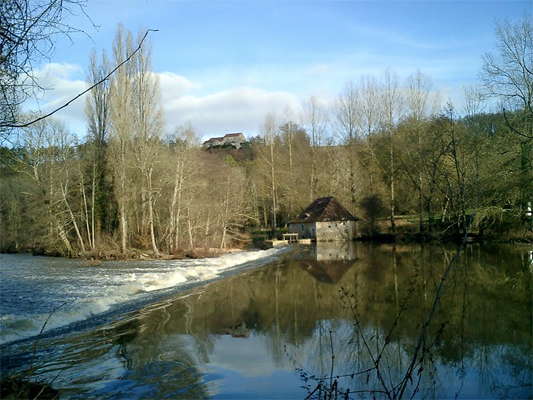
Mill on the Anglin, 300 metres upstream of the cliffs of Dousse. We can see the cliff bordering the Anglin in this photo.
Photo: mandeix via Panoramio
The Anglin River, a quite modest watercourse, actually crosses Vienne on only a very small part of its course (five or six kilometres), and only shortly before passing through the small but picturesque town of Angles, where it enters the département, before flowing into the Gartempe, itself a tributary of the Creuse.
The latter part of this course, takes place in a beautiful valley - surrounded by beautiful limestone cliffs, where there are many caves. About a kilometre before reaching the Gartempe, the Anglin which at that time flows from east to west, along the cliffs that limit, to the south, the plateau of the village of Dousse, and where it has dug a deep valley. It is in these cliffs that we find the cave that is the subject of this study.
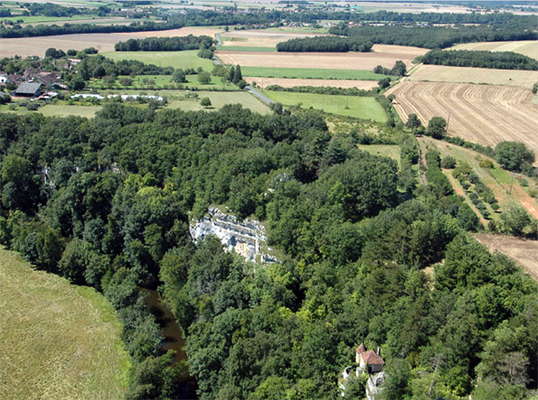
Aerial view of the cliffs of Dousse containing the caves.
Here we can see the Anglin River, the cliffs with the caves, and the broad plateau behind, with the beginnings of the village of Dousse on the left of the photo.
Photo: © Philippe Plailly, Geneviève Pinçon
Source: http://www.catalogue-roc-aux-sorciers.fr/
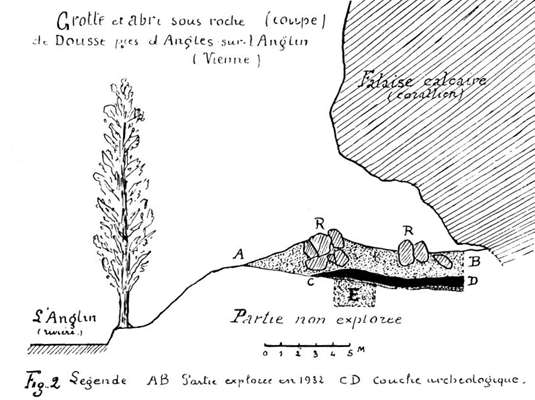
Cave and abri of the Dousse near Angles-sure-l'Anglin (Vienne)
AB part explored in 1932
CD Archeological layer.
The cave known as Cave à Lucien Jacob (now known as Cave Taillebourg - Don ) is rather small. It is listed on the cadastral map in piece No. 786, Section F. (In the region of Angles-sur-l'Anglin, grottes are all known as caves, and carry the name of the owner, or of a former owner of the land. )
Its dimensions are 8 or 9 metres deep, and only about 5 or 6 metres wide, but it is preceded by a beautiful terrace overlooking the river, well protected by an overhanging rock that makes it into a superb rock shelter. (The cliff consists of coralline limestone, with numerous coral polyps or madrepores, with some siliceous limestone.)
At this point the rocky cliff more than 20 metres high completely protects the area from northerly winds, and the site is in full sun. This means that this location was ideal for occupation by prehistoric man, and there I decided to make excavations on the first visit that I made there in December 1927.
(The Grotte des Cottets, well known for the remarkable excavations of Roche-Brune in 1881, and those of l'Abbé Breuil in 1905, are only about two kilometres as the crow flies from Dousse. )
Photo and text: Rousseau (1933)
By courtesy of the owner of the land, M. Taillebourg, of Angles-sur l'Anglin, who was good enough to grant me the right to dig there, I was able, on my second day at work, to establish that the cave, and the terrace, had been inhabited, and collect the first flints, in an untouched archaeological layer.
Description of the cave
Before discussing the findings, it is necessary to make known the aspect presented by the deposit and the state of the archaeological layer encountered.
Successive rock falls of limestone detached from the cliff above were at the foot of it, a pile of debris which was at an elevation of about 7 or 8 metres above the river level, and then sloping steeply to the water's edge, as in the diagram.
Scattered large blocks filled the cave to a large extent. At the start of my excavations, the entry was only a metre high. In addition, a group of large fallen limestone boulders lay at the base of the cliff, crossing the first access trench, testifying to the intense erosion which had occurred since the occupation of the cave, and to the raising of the ground level.
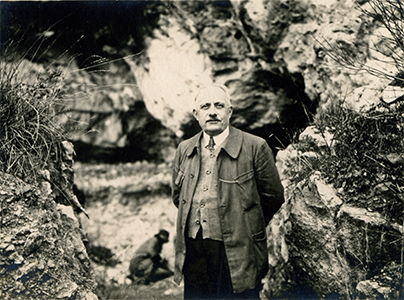
Portrait of Lucien Rousseau, March 1928
Photo: MAN, Fonds Saint-Mathurin
Source: http://www.sculpture.prehistoire.culture.fr/en/roc-aux-sorciers.html
The archaeological layer with an average thickness of 50cm is covered with sterile debris of about 150 cm to 180 cm thickness, and is entirely of a Magdalenian deposit, embedded in an alluvial sand brought down by a major flood of the river Anglin, and that has certainly driven out the occupants at that time. (The thickness of the archaeological layer formed by the occupants of the cave was increased by the contribution of this alluvial sand in which the objects found were dispersed by the stirring current.)
The river level is now, in the summer period, 5 or 6 metres below the Magdalenian layer, but I saw in 1930 a flood of the Anglin, which reached two metres below the layer explored. Small wonder, then, that during the period of habitation of the cave, when the snowfall was much greater, a bigger flood reached and covered the inhabited part of the cave.
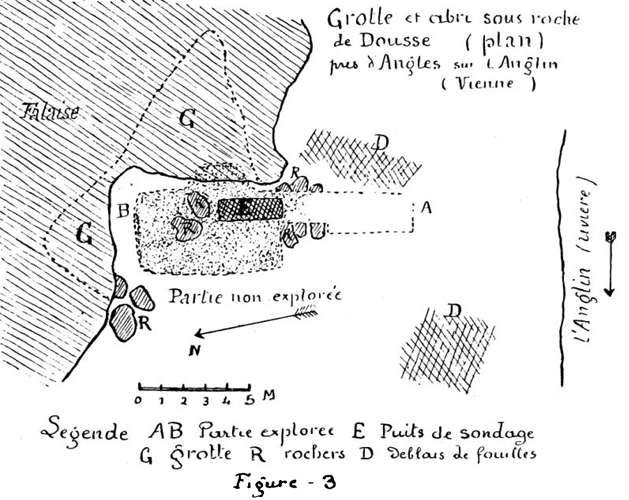
Plan of the cave and abri of the Dousse near Angles-sure-l'Anglin (Vienne)
AB part explored.
E sondage (test excavation to a deeper level to establish stratigraphy) pits
G cave
R rocks
D spoil from the excavation
Photo and text: Rousseau (1933)
The silty alluvial deposit having invaded the terrace and the cave which is strewn with blocks of limestone and the ash from fireplaces creates a highly resistant matrix which makes extraction of artefacts very difficult and facilitates breakage of the pieces, especially bones, despite great precautions, and despite the good preservation of the latter. It is very difficult to sieve the material though I did this as often as necessary.
In general, the layer, although very homogeneous, suffered as a result of water movement, an upheaval that has moved some of the flint and the heavy pieces to the bottom, while some light parts remained on the surface, such as bone, or were washed away, or were collected in a few pockets by the eddies.
Thus while it was possible to complete the plan of the whole area, my searches were performed mainly on the terrace in front of the cave. This part indeed abounded in well-established hearths in the middle of large calcareous plates, which by their weight contributed to a low current, and retained most of the bone pieces found.
Over this sterile alluvium layer of debris, to a thickness of approximately 160 cm, dotted with large boulders, there was, however, no trace of later occupations, except to find, almost at the surface two or three fragments of pottery, mostly from the Middle Ages.
In summary, the boundary height of the deposit, and the stratigraphy were easily determined, the station being reduced to a single layer well separated from anterior and posterior talus, whose white limestone contrasts sharply with the brown layer of archaeological level.
A deep sondage, looking for other possible layers, dug to 150 cm below the Magdalenian layer gave only negative results, although about 1 metre below, a slight zone of alluvial silt, demonstrated another previous smaller flood of the river. I propose to complete this part of the survey, and push if possible, to the basement rock.
Description of Artefacts
I will examine the finds made in turn, and divide the results into several sections.
1 Flints
2 Diverse pieces, grinders, pebbles etc.
3 Bone Industry
4 Jewellery, pierced teeth, pendants, marine shells
5 Animal bones
The Lithic industry
The majority of the flints collected were knapped from Grand-Pressigny flint, the pale flint from la Claisière, and the Larcy flint, which has enabled us to obtain large pieces of very beautiful execution. Le Grand-Pressigny is, moreover, only about twenty kilometres north of the cave. There are also some pieces of banded flint, and some black flint, with only two or three instances of yellow jasper flint similar to pieces found near de Barrou or de Fontmort. The pieces had no patina.
I would first like to report the find of a large deposit of blades of Grand-Pressigny flint, struck from the nucleus, before any retouching, nine in number, and found together under a big limestone plaque. No doubt this was a hiding place of reserves of good raw material for its lucky owner, but it also confirms the assumption, often expressed, that only blades detached from 'livres de beurre' or 'pounds of butter' were exported or traded from their point of origin. The largest of the nine blades measured 22 cm in length, but it was unfortunately broken in two during its recovery.
(These 'livres de beurre' or 'pounds of butter' were large, high quality, and therefore valuable, flint nodules found in particular at Grand-Pressigny. The name was given to them in modern times by the labourers of Grand-Pressigny. A typical large 'livre de beurre' was described as being 34 cm long, 11 cm wide and thick, and weighing 4 kilograms by Martin (1906).
It should be realised that not only was the flint of good quality, but the core was so large that very large blades could be struck from it, opening up all sorts of possibilities for a skilled knapper.
These must have been a wonderful asset to the people who owned the territory where the 'livres de beurre' were to be found. It is no wonder that they apparently only traded the blades they struck from their 'livres de beurre', and not the far more versatile flint nodules themselves, adding to the scarcity and desirability of the resulting tools.
I can imagine it now: 'That's not a knife. This is a knife!'
'Value adding', and what's more a monopoly on a very valuable item, started in the Palaeolithic! - Don )
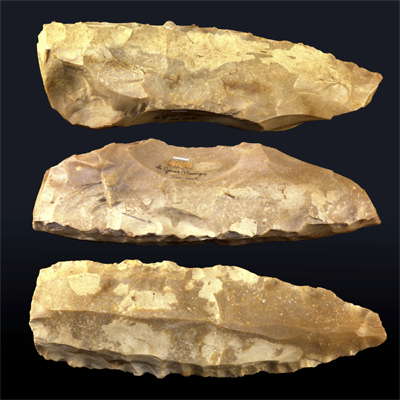
'Pound of butter' flint core or nucleus, the remaining part of a 'livre de beurre' after many blades had been struck from it.
Different views of the same specimen.
Date: between 9 000 and 3 500 BP (Late Neolithic)
Dimensions: 37 × 12 × 11.2 cm
Current Location: Toulouse Museum
Inventory number: MHNT PRE.2009.0.191.1
Found at Le Grand-Pressigny , Indre-et-Loire , France in 1886.
Edward Harle Collection (1850-1922), gift of Edward Harle
Photo: Photograph by Rama , Wikimedia Commons, Cc-by-sa-2.0-en
(Note the scar left from a blade at least 30 cm long struck from the core on the bottom photograph! - Don )
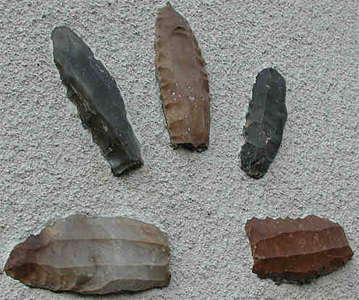
Flint from Grand-Pressigny
Photo: © Rengert Elburg, 2002, http://www.flintsource.net/flint/F_barrou.html
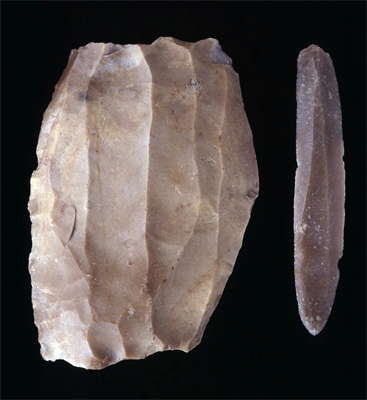
This is a 'blond' core from la Claisière, with an unidentified blade.
The 'blond' flint from la Claisière is described as a chert by the British Museum.
Photo: http://www.britishmuseum.org/, Donated by Christy Fund
Some cores, however, are found at the gisement, but these are only small conical nuclei of the Magdalenian type, from which were detached ordinary small blades, found in large numbers, as well as backed blades equally numerous.
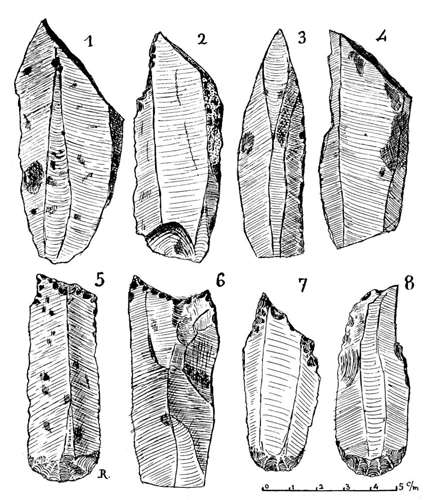
Plate I
Burins. - Burins are reasonably numerous and show the classical forms, with a fairly large majority of burins worked straight on the longitudinal axis of the blade, or middle median (left, Fig. 3). The other types are slightly less numerous. However, there are a few angled chisels with a straight truncation (left, Fig. 5), surviving from the method of the upper Aurignacian. In greater abundance, we find very pronounced oblique burins (left, Fig. 1, 2, 4), and in another form the burin busqué, or the parrot's beak burin, (left, Fig. 8, which carries a grattoir or scraper on the other end) but these are rare.
Perçoirs (awls) Figs 5, 7 with grattoirs on their other end.
Figure 6 shows a very rare concave scraper on the end of a blade found at the gisement. It is very well executed.
Photo and text: Rousseau (1933)

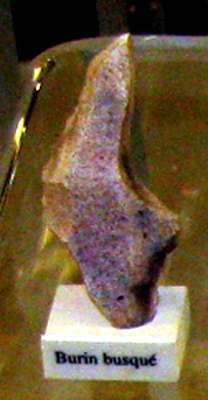
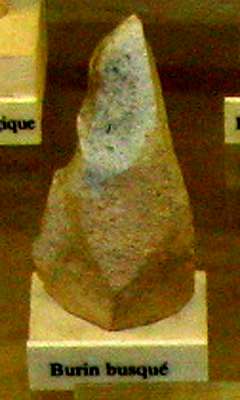
From Abri Pataud, a characteristic Middle Aurignacian tool - the burin busqué, or the parrot's beak burin.
It is a solid, heavily constructed tool whose bevel is formed by a large reduction of diameter from a large base to a relatively small point.
Photo: Don Hitchcock 2008
Source: Display at Abri Pataud Museum. These appeared to be originals.
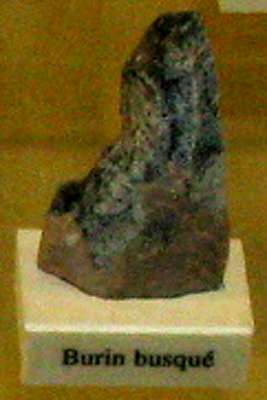
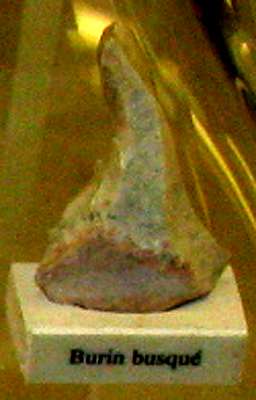
The beaked burin or burin busqué is especially common in the Middle Aurignacian. In appearance it rather resembles the prow of a ship turned upside down; the working edge is convex, being formed by a flat graver facet on one side, and a series of convex graver facets up the prow; this produces a keeled scraper made on the breadth of a blade. There are two sub-varieties, one with a notch to prevent the little convex graver facets from going too far down the blade, and the other without. (Burkitt 1925)
Photo: Don Hitchcock 2008
Source: Display at Abri Pataud Museum. These appeared to be originals.
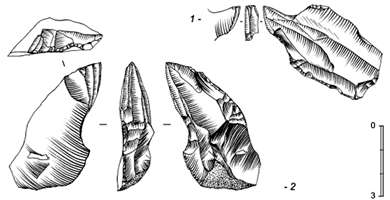
Burin busqué - the Beaked Burin
Burin busqué, n°1 : shelter 2, layer 2 and burin busqué near of the Vachon’s type, n°2 : shelter 1, layer 2 (drawings D. Pesesse).
Photo and text: http://paleo.revues.org/index184.html

Burin busqué - the Beaked Burin
Three or more fairly regular spalls, often removed from a Spall Removal Surface (SRS) of dihedral type, approximate a semicircle. An edge of this shape is sometimes described as the "gouge" or "busqué" type.
Text above: Movius et al (1968)
(This is an excellent diagram of what I think of as a "classic" beaked burin, as described by Burkitt (1925) above. Note the front vertical spall, and the notch taken out of the rear of the burin to make sharpening easier, so that a spall comes off easily when retouching. - Don)
Photo and text: Movius et al (1968)
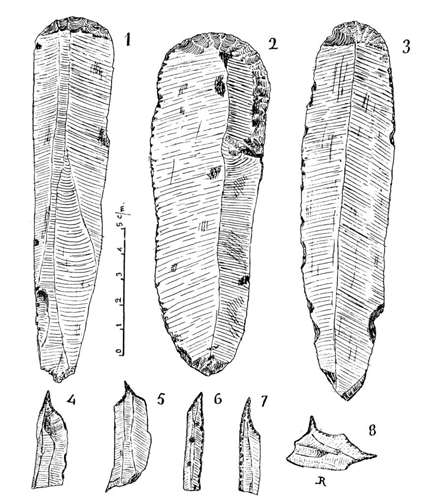
Plate II
Grattoirs, or scrapers, are, of all the pieces found, those which occur in the greatest numbers, and it is the grattoirs which provide the finest pieces with superb retouches. (left, Fig. 1, 2, 3)
They come in all sizes, confirming frequent use. (Grattoirs are usually understood to have been used in scraping animal hides to make them flexible - Don )
Many, however, are double ended tools (Plate II, left, Fig. 1, 2, 3, Plate I, above, Fig. 5, 7, 8) and carry on their other end a burin (Fig. 1), a perçoir (small drill or awl), or a taraud, (large awl or pointed digging tool, often used for wood, and often of rough workmanship )
Among them, however it should be pointed out three or four scrapers, worked on very broad blades, with retouches on one or both sides (Plate III, Fig. 7), recalling the technique used on some of the Solutrean scrapers from Laugerie-Haute and Badegoule. The quality of the flint has permitted the creation of two particularly beautiful scrapers 14 cm and 15 cm long, with an average width of 2.4 cm and 3 cm (Plate II Fig.1, 3).
Plate I, Figure 6 shows a very rare concave scraper on the end of a blade, found at the gisement. It is very well executed.
Photo and text: Rousseau (1933)
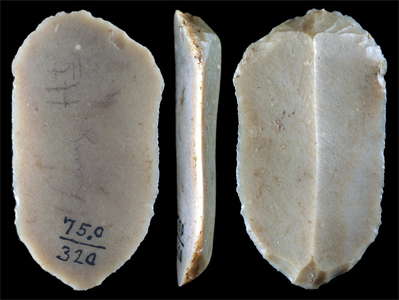
This Solutrean double-ended scraper made from a blade is from Laugerie Haute. The scars of two previously removed blades can be seen on one side and the smooth surface of the detachment flake can be seen on the other. Single and double ended scrapers are one of the most common tool forms that have been found on sites around the world. This scraper is made of a very high quality semi-translucent grey chert. It measures 2 5/16 inches (5.9 cm) long and 3/8 inch (.9 cm) thick.
Photo and text: © Peter A. Bostrom, American Museum of Natural History Collection, http://lithiccastinglab.com/gallery-pages/solutreandoubendscraperlarge.htm
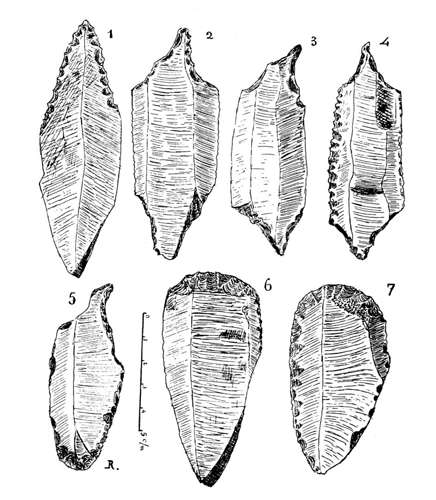
Plate III
Large borers (perçoirs) on blades Figures 1, 2, 3, 4, 5.
Many of the pieces found are dual use tools, and carry one end which is a burin, as in Plate II Figure 1 or a scraper as in Plate III Figure 5.
Figures 6 and 7 are grattoirs with large, heavy duty borers (tarauds) on the other end.
Photo and text: Rousseau (1933)
Perçoirs and tarauds. - Many awls and heavy borers or fragments of these tools, beautifully made, are among the items collected.
All sizes are represented, from the large awls on blades (Plate III, Fig. 1, 2, 3, 4, 5), to fine tools on flakes (Plate II, Fig. 4, 5, 8) , and even manufactured from used blades with blunted backs (Plate II, Fig. 7).
Almost all are made from Grand-Pressigny flint, the quality of which favours the ease of fabrication of these beautiful small pieces.
As usual, many are dual use and carry at the other end a scraper (Plate Ill, Fig. 5) or a burin (Plate III, Fig. 1). Some show evidence of prolonged use.
Blades with blunted backs - Blades with straight blunted backs, and parallel sided, of the Gravettian type were found in large numbers, and I collected more than 200 from the excavated part of the site. They are almost all substantially the same size and measure 4 cm to 5 cm average length, with a width varying from 5 mm to 7 mm.
Some are of a translucent white flint. One of them was even transformed into a tiny oblique burin (Plate II, Fig. 6). The number of these pieces is far from being as great as that of ordinary small blades, raw flakes, more than five or six hundred, which carry traces of use in considerable numbers on their edges.
Large blades have not undergone such clearly defined use, are in smaller quantities and have been mainly used on the sharp edge, the two ends being retained in their original state. The large blades discovered have already been discussed. Many 'coups de burin', or 'burin blows', and the resharpening of the burins, show the frequency of their use.
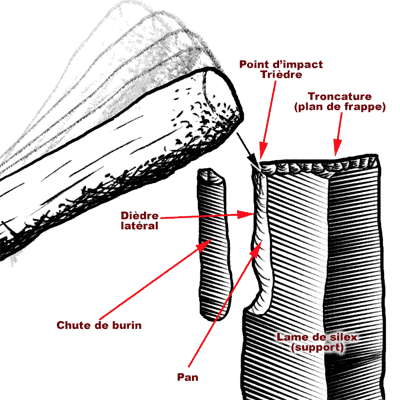
Coup de Burin
The technique of the 'Coup de Burin'.
The active part of the chisel is obtained using a special knapping technique, called the 'burin blow technique', which is to detach, usually with a soft hammer, a small chip in the lamellar thickness of the substrate to create a steep side panel more or less perpendicular to the plane of flattening of the media. The detached lamellar chip is called the 'chute de burin' The dihedral obtained is very robust rather than sharply angled, and the burin may be revived many times by detaching further chutes.
Photo: José-Manuel Benito Álvarez
Permission: Creative Commons Attribution - Share Alike 2.5 Generic
Text: Wikipedia
2 - Miscellaneous Items. - pebbles, grindstones, etc.
Although pebbles, large pebbles of quartz, mostly, as well as granulite, (coarse–grained metamorphic rocks ) and various other rocks, from the nearby river, are abundant, I have not found on any of these blocks, damaged areas reflecting their use as hammers. I think rather that their abundance and their presence in and around hearths, is consistent with the hypothesis already issued, to enshrine their use following the fashion still currently used in some savage tribes to warm, water or liquids in containers made of skin using very hot pebbles; this custom is still practised in Corsica, and Corsican shepherds use red-hot river or sea pebbles to bring to a boil, milk for cheese making which the locals call Ricotta. However, two of these pebbles had a different role to play, and they have retained the imprint of their original use.
One carries very clear traces of ochre, and the other manganese dioxide.
However it was the raw materials of both these dyes that I found in abundance in the deposit, in particular manganese, and some fragments of chalk.
I even found not far from the pestle, coloured by manganese and completing the pair of tools, the grindstone, if you can call it that, on which the Magdalenians crushed their colouring matter. In this case, it was a fine granulite block, a rock foreign to the region, and probably from the river, 35cm by 20cm long and wide, with a thickness of 8 cm to 10cm.
It had a flat face and was highly polished by use, and it retained on its surface traces of dense black crushed manganese. As in all Magdalenian sites previously studied, we found that at Dousse there was great use of colouring materials.
Rock crystal. - Two small pieces of rock crystal, hyaline quartz (opalescent white quartz), from the alluvium of the river were also found. One had been worked, and fragments had been detached from it, while the other retained the partially frosted appearance that indicates it had been subjected to wear in the bed of the river.
3 - The Bone Industry
The raw material used in this site is made up mainly of reindeer antler, then bone and ivory.
Weapons. - One can hardly fail to put into this category spearheads, found whole or fragmented, in total 17.
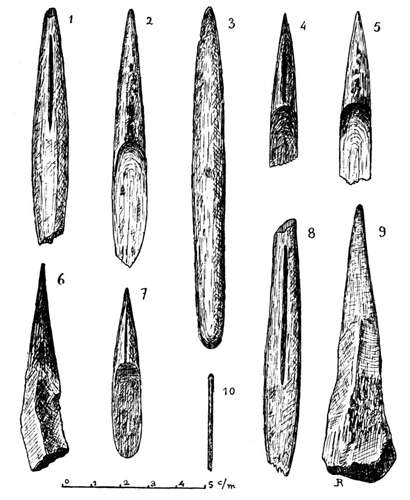
Plate IV
The bone Industry of the site.
Photo: Rousseau (1933)
Carved from reindeer antler, points are of the conventional type (Plate IV, Fig. 1, 2, 4, 5, 7, 8), but they are rather short and stocky with oval or slightly quadrangular cross section. The tapered single bevel section shows evidence of grooves and ridges sometimes noticed at other sites, and intended to facilitate adhesion to the support to which it was anchored. They are without any engraving, stylised or not stylised.
The tip in all the examples found have fairly deep grooves, and repeated in some specimens on both sides. These were probably intended, as has been said many times, to store the poison with which the weapons were coated, which would otherwise have been of limited effectiveness against large animals at the time.
However, one piece (Plate IV, Fig. 3), made of reindeer antler, which I filed under the category of spearheads, does not seem absolutely designed to fulfil this role. The length of 13cm is greater than that of ordinary spears, the tip is slightly rounded and the base is terminated by a round, ovoid shape. In a state of excellent preservation, it has no groove and is one of the few pieces collected without fracture. Should we see a primitive harpoon?
Needles - Some needles were found, few I think, because of the difficulty of isolating them in the midst of the resistant matrix in the archaeological layer, and I have only four fragments, one with the usual eye, but with a broken tip (Plate IV, Fig. 10). They are made of ivory.
Baguette in Reindeer antler - A cylindrical baguette in Reindeer antler, broken in ancient times, of 15 mm diameter, and a length of 120 mm, is difficult to identify with regard to use, but it could be part of a dagger, or a baton used for straightening spears.
Awls - This tool, common to all gisements, occurs also at Dousse. They are of the classical forms, and consist of fragments of reindeer antler (Plate IV, Fig. 6), bone fragments (PI. IV, Fig. 9). A very nice specimen is made of ivory, with a very fine edge, but it is unfortunately incomplete. Traces of sharpening are clearly visible.
Smoothers. - Some smoothers formed by bone fragments are flattened through use (ribs?), but are found only in small quantities.
Pieces of ivory - Two fragments of mammoth tusk bearing deep longitudinal grooves made by a burin are evidence of the detachment of splinters of ivory from tusks, the splinters then being used in different ways. (Possibly for such purposes as needles - Don )
4 - Jewellery
Among the items of jewellery at the site are included:
1 - Pierced teeth, bone pendants, or ivory.
2 - Marine shells.
3 - Stone pendants.
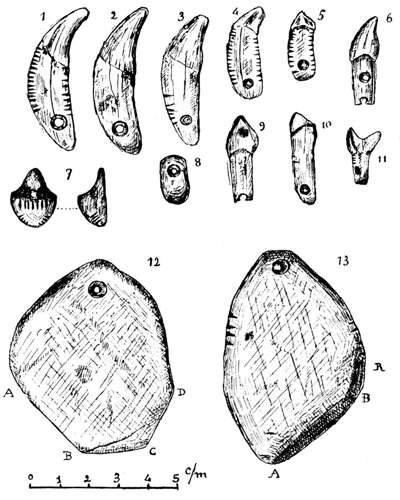
Plate V
Parures, Jewellery from the site.
1 - Wolf tooth with 24 notches, 16 on one side and 8 on the other.
3- Wolf canine, with the beginning of a perforation on one side, and some notches.
4 - Wolf tooth a total of 32 notches cut in it.
7 - Ivory pendant.
8, 9, 10, 11 - Deer teeth, oddly shaped.
12, 13 - stone pendants
Photo: Rousseau (1933)
Pierced teeth, bone pendants, or ivory - The pierced teeth of animals which formed necklaces, or were part of them, are quite numerous. There were 22 found during the excavations of the cave. They consist mainly of the canine teeth of Wolf, Reindeer incisors, and some Fox canines.
A certain number carry on the side 24 notches, for example on the Wolf Canine (Plate V, Fig. 1), comprised of 16 on one side, and 8 on the other.
16 notches also appear on one side of the wolf tooth shown in Plate V, Fig. 4, with, on the other side, 11 notches, and 5 below, totaling 32. We also find 32 notches on the tooth shown in Plate V, No. 5, across three rows. Should we see a coincidence, or should we conclude that the Magdalenians had a rudimentary counting system?
Two of the pierced teeth are atrophied Deer teeth, oddly shaped (PI. V, Numbers 8-11). A Wolf Canine (PI. V, Number 3) has only the beginning of a perforation on one side, however it carries a few notches.
Some of these teeth, having long been used, show wear which has caused part of the tooth to disappear, leaving just traces of the notches originally cut in the tooth.
Ivory pendants. - I particularly want to report the discovery of ten apparently ivory pendants, of a special form not yet reported frequently, of different sizes, the model featured (Рlate V, Fig. 7) being the largest of those gathered. This type of pendant looks almost exactly like that described by Dr. Gobillot, of la Trimouille (Vienne), and from another cave in that département, that of Fadets à Lussac-les-Chàteaux, also the from the Magdalenian. It is the same shape, differing only by some diversity in the notches, and in the points of decoration.
(Note that this ivory pendant is also very similar to those called 'basket beads' from the Castel-Merle area of the Vézère region, and presumably were made in the same way, see above on this page - Don )
Should we see a common cultic manifestation or the manufactured product from the same artisan? The combination of both caves allow these hypotheses.
Marine shells. - Marine fossil shells, probably fossils from the Miocene shelly sands of Touraine, numbering about twenty, were also part of necklaces, and as such were pierced in order to be suspended.
Of these shells, it must be noted especially the abundance of the upper valve of scallops or pecten, (coquilles Saint Jacques) but all are fragmented.
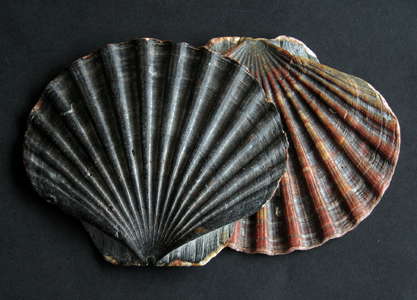
Two beachworn upper valves of Pecten maximus from Wales.
Photo: Manfred Heyde
Permission: Creative Commons Attribution-Share Alike 3.0 Unported license.
Stone pendants - Four pendants of stone, substantially all of equal size of 40 mm to 50mm wide, and about 70 mm to 80 mm in length and fairly thick, were found among the hearths (Plate V, Fig. 12 and Fig. 13). These are river pebbles of mica schist, with a hole for hanging at one end. One of them carries eight notches placed symmetrically on either side in groups of 4.
The lower part, opposite the hanging hole shows very pronounced signs of wear: the pendant on the left (Plate V Fig. 12) in two places from A to B, and С to D, and pendant on the right (Plate V. fig. 13) from A to B, these parts having been worn almost straight.
The other two non-figurative pendants, also carry the same signs of wear, although less pronounced on one of them. What use could these objects serve? Perhaps they were not, strictly speaking, pendants, but were simple smoothers, whose frequent use required the presence of a hole and suspension in order to prevent their too frequent loss.
5 - Bones of animals, Fauna
The fauna of the site comprises a very large amount of various bones, fairly well preserved, especially in the better protected part of the shelter, but almost all very fragmented as usual.
I could discern in particular reindeer, horse, mammoth (fragments of tusks), the wolf, the fox, the cave bear, the roe deer, as well as different bones of small carnivores and birds, teeth of rodents, and a fish vertebra. Reindeer bones dominate, with fragments of metacarpals, all broken at the same location, as well as teeth, jaws and large fragments of antlers, very fossilised.
Next comes the horse, nearly as abundant, then the wolf, of which many examples were certainly brought into the cave, since the number of canine teeth found, some pierced, some not, amounted to seventeen (many were still set in the front part of the jaw) without counting the other teeth or bone fragments from wolves. Then comes the fox, roe deer, the cave bear, (some bones) and other small carnivores and rodents.
Note that I did not report aurochs among the fauna. I have not, indeed, so far, found any bones that may relate to this animal.
Despite the care taken in this research, of all the bones which have been collected and examined, I could find so far no trace of engraving, unless we put into this category the horse teeth of which I will give a description.
Engraved horse teeth
The fauna of the gisement include a large quantity of horse bones. Horse remains at this site seem to be as abundant as reindeer, the teeth of these animals are frequently encountered and are juxtaposed with jaw fragments, all of excellent preservation.
Of these teeth, mostly incisors, and from animals of all ages, I have collected five deserving a special description because of their peculiarities. These five teeth, indeed, were the subject of carefully completed engravings, something that, to my knowledge, has not yet been reported elsewhere. (Note, however, the photo and text below from a later paper (Péricard et al., 1940) about similar horse teeth found after this date at La Marche, from which the teeth at Roc-aux-Sorciers may well have come - Don )
These teeth are incisors, young animals with no wear of the dental table.

Plate VI (called Fig. 4 in the original paper, Rousseau (1933) )
Engraved teeth of horses.
(Tooth number 1 in this plate is now catalogued as BDD 294, as shown in the modern colour photographs below.
Note also that large numbers of horse teeth decorated in this way were found at La Marche, commune de Lussac-les-Châteaux (Vienne), which may be the origin for all the examples found in the area. See below - Don )
Photo: Rousseau (1933)


Worked tooth - BDD 294
Roc-aux-Sorciers, Taillebourg Cave
layer: Unknown (Magdalenian).
Material and technique: Ivory.
Length: 58 mm; Width: 17.5 mm; Thickness: 11 mm.
Foal incisor in good condition.
Provenance: Rousseau Collection.
Decor Technique: incision.
Incisions on both sides of the tooth using the same process, namely: a set of three deep lines on the distal part, one of three very fine short lines in the mesial, and a series of three deep lines deep in the proximal.
On the lingual surface, in the mesial, a cross engraved; also on the lingual surface in the proximal part, a trapezoid encloses a grid or crosshatching (20 lines in each direction).
Comment: Light wear on the chewing surface. Significant traces of pigment (red ochre?) within the grid.
Bibliography: Tooth 1, Fig. 4, Page 255, Rousseau (1933)
Photo: Dent aménagée (BDD 294) : document de travail.. © Jacques Lemounier, ill. Guy Mazière, 2008.
Source: http://www.catalogue-roc-aux-sorciers.fr/
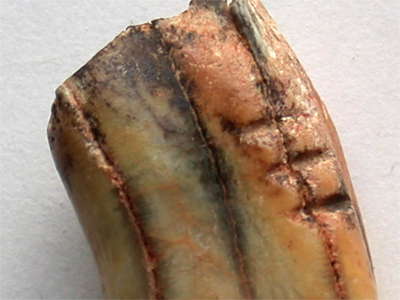
Worked tooth - BDD 294
Roc-aux-Sorciers, Taillebourg Cave
layer: Unknown (Magdalenian).
Material and technique: Ivory.
Length: 58 mm; Width: 17.5 mm; Thickness: 11 mm.
Foal incisor in good condition.
Provenance: Rousseau Collection.
Decor Technique: incision.
Incisions on both sides of the tooth using the same process, namely: a set of three deep lines on the distal part, one of three very fine short lines in the mesial, and a series of three deep lines deep in the proximal.
Bibliography: Tooth 1, Fig. 4, Page 255, Rousseau (1933)
Photo: Dent aménagée (BDD 294) : document de travail.. © Jacques Lemounier, ill. Guy Mazière, 2008.
Source: http://www.catalogue-roc-aux-sorciers.fr/
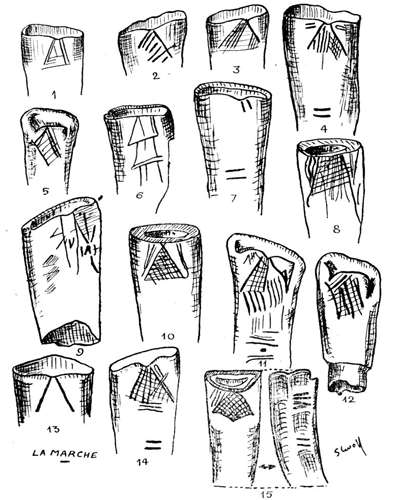
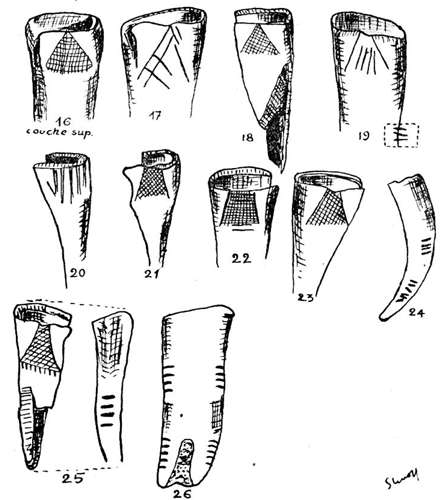
Engraved horse incisors from La Marche, commune de Lussac-les-Châteaux (Vienne).
Note that the shape of the etching does not always take the shape of a triangle, though it is a common shape for the design.
These etched horse teeth characterise the deposit of La Marche. Incisors bear on the top of their inner surface, a cross hatched triangle more or less well formed. One of the bases is the edge of the worn tooth: the other two sides, limited by one or two strokes sometimes roughly etched are substantially symmetrical with respect to the axis of the tooth. The filling of this area is completed by a fairly regular grid. The teeth are always isolated maxilla.
This tectiforme (?) sign is accompanied sometimes by one or more fairly deep notches, parallel to the edge of wear and located halfway up the sides of the root. These notches are symmetrical and are on the edges. One of them has, in this middle part of the tooth and on the same side a cruciform sign (it is not drawn on the plate).
It is useless to speculate on these objects. Teeth of the kind we have just described have been reported very rarely.
Abbé Breuil pointed one out to us at Laugerie Basse (National Collection) and he has found one in la grotte des Fadets de Lussac-les-Châteaux. M. Rousseau reported the presence of eight similar teeth in the field of Dousse (Angles-sur-l'Anglin), relatively close to La Marche, and at the same archaeological level (Rousseau, 1933).
La Marche accounted for 31 similar teeth. If one accepts that the number of occurrences indicates the place of origin, it is tempting to consider La Marche as the place from which all the others came.
Photo and text: Péricard et al. (1940)
In the concave portion of each tooth at a location identically the same for the five specimens collected, that is to say on the part protruding from the gums during the animal's lifetime, there is a very fine grid checkerboard , very clear and included in an isosceles triangle for two teeth in a trapezoid for the other 3 (Plate 6).
The grid is clearly limited by a straight line, and the interior is filled by a series of engraved lines, crossing diagonally and forming tiny squares.
Two of the incisors, and these are the ones where the grid is the most carefully incised - and the clearest - bear also specific signs, which consist of notched distributed in groups of three on one example, a total of 18 notches because there are three groups of three on each side of the tooth, while on the concave portion of the tooth, in the greater curvature below the grid, is engraved with two notches cut diagonally and forming a cross of St. Andrew. (Plate 6, No. 1). (These notches shown on the drawing are not apparent on the colour photograph. Perhaps they are out of frame further behind the face which is showing - Don )
The second example with notches has just six, three on each side, symmetrically arranged on both sides of the tooth. This tooth is the remaining part of the root broken in ancient times, and other notches could have disappeared.
How were these engravings made on enamel, a very hard material, and what do they mean?
A trial with a flint blade, taken from the site, on another horse incisor showed me that, despite the hardness of enamel, there was the ability to perform this work, despite rapidly eroding the edge of the flint. Perhaps the two pieces of rock crystal,found, provided fine flakes, more resistant than the flint and better able to make these engravings for which you can admire the regularity of features, on a very hard material.
It is difficult to be sure about the reason for these engravings and their use. Marks for hunting, shall we say? Pendants? The suspension would have been difficult, especially for three of the examples which do not bear notches. Perhaps they are intended for fetishes to promote success in the hunt for their lucky owner, and provided by a skilled sorcerer group? Many questions such as these are very difficult to solve, but are likely to attract the attention of prehistorians.
Engravings on slabs of limestone
As I said earlier about animal bones, on which I have found so far no engraving, but only a few marks of cutting, I paid a lot of attention to all likely limestone slabs, which, by their surface smoothness, may have attracted the burin of Magdalenian engravers.
Some graffiti found in hearths and on fragments of calcareous plaques, where it is, I believe, impossible to discern any representation, led me finally to find on a large fragment of a roughly flat slab, a confusing array of features, where by dint of patience and careful angling to an oblique light, I was able to isolate from the rest of the set the representation of an animal, which though incomplete, is obviously a Mammoth walking in profile.
The animal is seen on the left side, with a protruding belly, and with this and the feet, so characteristic of the animal, I was able to identify it. The head was impossible to find in the confused mess of tangled lines. The line of the mammoth is regular, and a little more deeply etched than the surrounding features, which also facilitates its identification.
Conclusion In summary, the site discovered in the Dousse cliff, the grotte of the "Cave à Lucien Jacob " as a result of discoveries made , and the study of these artefacts, seems to me to be attributed to the Lower Magdalenian.
The flint knapping technique, shown by a few Solutrean points, (particularly similar to a few scrapers), the lack of full harpoons, even the primitive model with barbs on only one side, and the scarcity carvings so abundant in the terminal Magdalenian, argue, I believe, for the award reported.
The presence of all the usual Magdalenian tooling, beautifully crafted, thanks to the excellence of the raw material, and well isolated by the absence of any archaeological layer above or below, thus allows us to assign the occupation of the cave to the beginning of the Magdalenian, that golden Palaeolithic age.
I left in place the necessary controls, to permit verification, facilitate monitoring, and the correction of my assertions here, if applicable.
Undoubtedly, new research in other places in this beautiful region, will bring the discovery of other sites, and complement the modest contribution that I bring today to the prehistory of the Vienne.
The Frieze at Roc-aux-Sorciers
The frieze on the wall at Roc-aux-Sorciers (Angles-sur-Anglin, Vienne) dates to the Magdalenian III: by 14 000 years ago it had a length of at least 30 metres. In its western sector (l'abri Bourdois) it has remained almost intact. In its eastern sector (Cave Taillebourg) it was dislocated or erased by erosion, but precious fragments enable it to be partially restored. Even today it defines a well dated cave wall, a stage of geomorphological revolution of the hillside, it captures the gradual transition from the habitat of a rock shelter to an outdoor habitat, and the contrast between two kinds of life: a dense middle Magdalenian occupation, followed by short stays in the upper Magdalenian.
At Roc-aux-Sorciers archaeological data, radiochronological data and palynological data have been determined for the topography which is immediately readable. We would like to try here, if possible, to connect a local sequence of very short duration, the general paleoclimatic sequence.
The frieze occupies the surface of a corbelled wall, the upper segment of hollow shapes in the bedrock. These forms are located on the edge of a cliff and a subvertical to steep rocky slope that descends from the cliff to the river.
The profile thus defined - cliff, gorge and slope - must be presented both as a structural relief, partly explained by the rock sequence, and the concave side of a bend in the river. This profile has been pretty much stabilised for a long time: by the time of the Magdalenian it was already, in essence, the one we know today.
However, during the Middle Magdalenian and especially during the Upper Magdalenian, rocks and dirt tumbled down from the cliffs above, and came to rest in the hollowed out section at the foot of the cliff, where the abri had existed.
This detritus now adds its thickness to the archaeological horizons.
The hollow shapes
The cave and abri Taillebourg - Bourdois were formed at the same topographic level.
Chemical or biochemical attack on a rock face is conditional on surface moisture during the warm or growing season; the breaking of rock by freeze-thaw cycles during colder months supposes that a 'critical concentration' of water is exceeded during the season of freeze-thaw cycles.
The water, which may be provided by atmospheric precipitation, can also be from an underground reservoir. The outlet to the air of a karst conduit determines the formation of a cavity surface that widens gradually. One can speak of a vestibule or hallway at the outcrop of a seasonal water table, the level determined by lithology, causing the appearance of a straight groove that develops into a moulding, concave, and elongated in a cavetto form, more or less horizontal: one can speak of an abri-cavetto.
(Note that a cavetto is a term from architecture, a concave moulding with a cross section of approximately a quarter of a circle. When looking at the area of the frieze, this terminology is apt - Don )
Text above: Guillien et al. (1976)
References
- Bourdier C., 2008: La frise sculptée de l’abri Reverdit (Sergeac, Dordogne) : première approche analytique des œuvres, Paleo, 20 | 2008, 23-46.
- Burkitt M., 1925: Prehistory: a study of early cultures in Europe and the Mediterranean basin, Cambridge, Cambridge University Press. 1925, Second Edition.
- Castanet, R., 2006: Les Perles de Sergeac en Périgord Noir Grapho 12 Imprimeur, 12200 Villefranche-de-Rouergue, ISBN 2 9510260 1-3
- Caldwell, D., 2010: The Identification of the first Paleolithic animal sculpture in the Ile-de-France: the Ségognole 3 bison and its ramifications, in Clottes J. (Dir.), L’art pléistocène dans le monde / Pleistocene art of the world / Arte pleistoceno en el mundo, Actes du Congrès IFRAO, Tarascon-sur-Ariège, septembre 2010 – Symposium 'Art pléistocène en Europe'
- Delage, C., 2012: De la pointe de sagaie a la culture de Lussac-Angles il ya plus qu'un pas. Argumentaire.S.E.R.P.E Bulletin n°62 2012- 23
- Delluc B. & Delluc G., 1981: Les manifestations graphiques aurignaciennes sur support rocheux des environs des Eyzies (Dordogne), Gallia Préhistoire , 21, 213–438.
- Delporte H., 1989: L’homme et son image, Le Temps de la préhistoire, dir. Jean-Pierre Mohen, Paris, SPF-Archeologia, 1989, vol. 1
- Laming-Emperaire A. , 1962: La Signification de l’art rupestre paléolithique, Paris, Picard.
- de Saint-Mathurin S., 1973: Bas-relief et plaquette de l’homme magdalénien d’Angles-sur-l’Anglin, Antiquités nationales, no 5, 1973, p. 12-19.
- de Saint-Mathurin S., 1974: Figure humaine du Magdalénien III gravée sur madrépore, abri du Roc-aux-Sorciers (Angles-sur-l’Anglin), Antiquités nationales, no 6, 1974, p. 26-28.
- de Saint-Mathurin S., 1978: Les 'vénus' pariétales et mobilières du Magdalénien d’Angles-sur-l’Anglin, Antiquités nationales, n° 10, 1978, p. 15-22, 6 fig.
- Didon L., 1911: L’Abri Blanchard des Roches (commune de Sergeac). Gisement aurignacien moyen, Bulletin de la Société Historique et Archéologique du Périgord, 87, 246–61 & 321–45.
- Didon L., 1912: Faits nouveaux constatés dans une station aurignacienne, L’Abri Blanchard des Roches prés de Sergeac, L'Anthropologie , 23, 603.
- Fuentes O., Pinçon G., Vanroose P., no date: Le Roc-aux-Sorciers, un site unique au monde, La revue de l'histoire no 58, Spéciale Patrimoine
- Gobillot L., 1919: Note sur deux Pendeloques magdaléniennes inédites de la Vienne, Bulletin de la Société préhistorique de France, 1919, tome 16, N. 4. pp. 192-195.
- Guillien Y., de Saint-Mathurin S. , 1976: Le gisement du Roc-aux-Sorciers et la séquence climatique du MagdalénienBulletin de la Société préhistorique française, Comptes rendus des séances mensuelles. 1976, tome 73, N. 1. pp. 15-21
- Laming-Emperaire A. , 1962: La Signification de l’art rupestre paléolithique, Paris, Picard.
- Iakovleva L., Pinçon G., 1994: Les représentations féminines dans l’art pariétal du Roc-aux-Sorciers à Angles-sur-l’Anglin (Vienne), Colloque international sur l’image de la femme dans l’art paléolithique, Brassempouy, juillet 1994, éd. Études et recherches archéologiques de l’université de Liège, ERAUL 74, 1995, p. 123-128, 1 fig.
- Iakovleva L., Pinçon G., 1997: Angles-sur-l’Anglin (Vienne), La frise sculptée du Roc-aux-Sorciers, RMN, CTHS, 1997, 168 p.
- Iakovleva L., Pinçon G., 1998: The upper palaeolithic sculptured ibex of Angles-sur-l’Anglin, France, Oxford Journal of Archaeology, vol. 17, n° 3, novembre 1998, p. 257-268, 7 fig.
- Leroi-Gourhan A., 1965: Préhistoire de l’art occidental,coll. 'L'art et les grandes civilisations', 1965.
- Martin H., 1906: Etude sur les 'Livres de Beurre' du Grand-Pressigny, Bulletin de la Société préhistorique de France , 1906,tome 3, N. 1. pp. 45-55.
- Movius H.L. Jr, David N., Bricker H., Clay B., 1968: The analysis of certain major classes of upper palaeolithic tools: Stratigraphy, American School of Prehistoric Research, Peabody Museum, Harvard University, Cambridge, Massachusetts
- Péricard L., David N., Lwoff S., 1940: La Marche, commune de Lussac-les-Châteaux (Vienne) : Premier atelier de Magdalénien III à dalles gravées mobiles (campagnes de fouilles 1937-1938), Bulletin de la Société préhistorique de France, 1940, tome 37, N. 7-9. pp. 155-180.
- Peyrony, D., 1935: Le gisement de Castanet, Vallon de Castelmerle, commune de Sergeac (Dordogne). Aurignacien I et II.- Bull. S.P.F., T. XXXII (19): 418-443.
- Pinçon G., 1993: Rapport d’activité sur le site du Roc-aux-Sorciers à Angles-sur-l’Anglin (Vienne), 1993.
- Pinçon G. et al., 1999: Le Roc-aux-Sorciers. Relevés d’art pariétal, rapport d’activités intermédiaire, 1999.
- Pinçon G. et al., 2004: Le Roc-aux-Sorciers. Relevés d’art pariétal, rapport d’activités intermédiaire, 2004.
- Pinçon G., 2005: À la recherche du cheminement d’idées au cours du Magdalénien: essai sur les représentations féminines du Roc-aux-Sorciers (Angles-sur-l’Anglin, Vienne), congrès du CTHS, La Rochelle, 2005.
- Pinçon G., 2007a: À la recherche du cheminement d’idées au cours du Magdalénien : essai sur les représentations féminines du Roc-aux-Sorciers (Angles-sur-l’Anglin, Vienne)Arts et cultures de la préhistoire, Paris, éd. du CTHS, « Documents préhistoriques », 24, 2007, p. 55-63.
- Pinçon G., 2007b: A topographical approach to parietal figures : the monumental sculptures of the Roc-aux-Sorciers (Vienne, France), produced in daylight at the back of rockshelter and its ceiling, Palaeolithic Cave Art at Creswell Crags in European Context,edited by Paul Pettitt, Paul Bahn & Sergion Ripoll, 2007, p. 229-246.
- Pinçon G., 2008: Chronologie pariétale des oeuvres magdaléniennes du Roc-aux-Sorciers (Angles-sur-l’Anglin, Vienne): entre tradition et innovation, In Situ [En ligne], 9 | 2008, mis en ligne le 18 avril 2012, consulté le 14 août 2013. URL : http://insitu.revues.org/3292 ; DOI : 10.4000/insitu.3292
- Rousseau L., 1933: Le Magdalénien dans la Vienne. Découverte et fouille d'un gisement du Magdalénien à Angles-sur-l'Anglin (Vienne), Bulletin de la Société préhistorique de France, 1933, tome 30, N. 4. pp. 239-256.
- White R., 1989: Production complexity and standardisation in early Aurignacian bead and pendant manufacture: Evolutionary implications, in The Human Revolution: Behavioural and Biological Perspectives on the Origins of Modern Humans eds. C. Stringer & P. Mellars. Edinburgh: Edinburgh University Press, 366–90.
- White R., 2007: Systems of Personal Ornamentation in the Early Upper Palaeolithic: Methodological Challenges and New Observations. In, Mellars, Paul, Boyle, Katie, Bar-Yosef, Ofer and Stringer, Chris (eds.) Rethinking the Human Revolution: New Behavioural and Biological Perspectives on the Origin and Dispersal of Modern Humans. Cambridge, UK, McDonald Institute for Archaeological Research, 287-302. (McDonald Institute Monographs).
